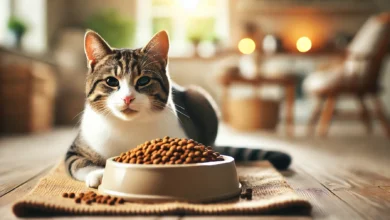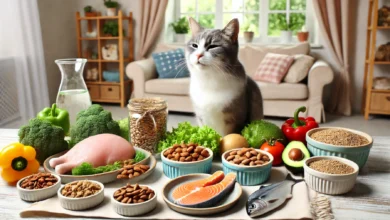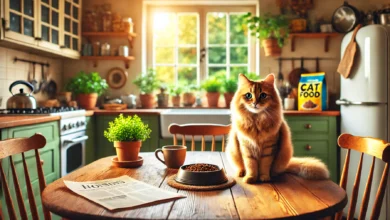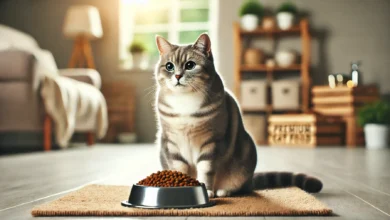How to Prevent Cat Obesity with Proper Diet
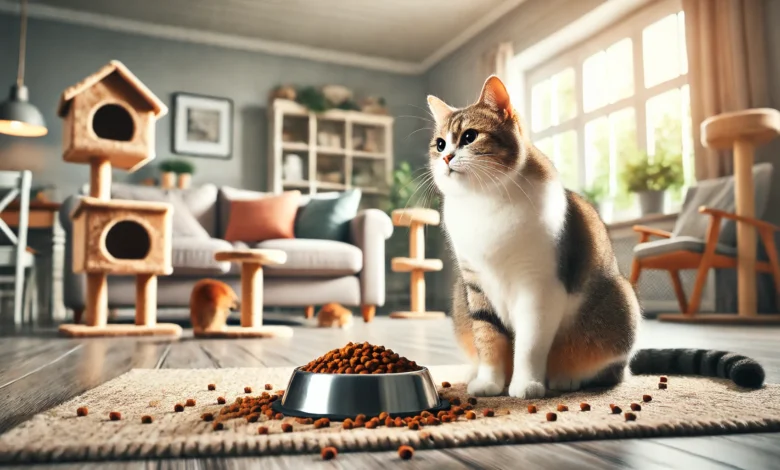
Cats are well-liked companions that bring warmth, affection, and joy into many homes.
Yet just like humans, if their nutritional intake isn’t keenly observed, cats may suffer from health setbacks.
One of the most common ailments in cats, which can lead to severe health problems if unheeded, is cat obesity.
As a cat owner, you want your furry friend to live a long and healthy life, and that starts with knowing how to avoid obesity through proper diet choices.
But how would you know if your cat is overweight, and what steps would you take to keep them at a healthy weight?
This article will take you through all that you need to know to maintain your cat in optimal health, avoiding the dangers of cat obesity.
Table of Contents
Understanding Cat Obesity: Causes and Risk Factors
Before trying to prevent obesity in your cat, it’s essential to understand what normally causes it.
Just like in humans, obesity in cats develops when there’s a mismatch between the calories they consume and the energy they burn.
In principle, a cat will store energy as fat when it consumes more calories than it burns.
Over time, this can lead to a serious increase in body weight and, consequently, cat obesity.
But what triggers this imbalance?
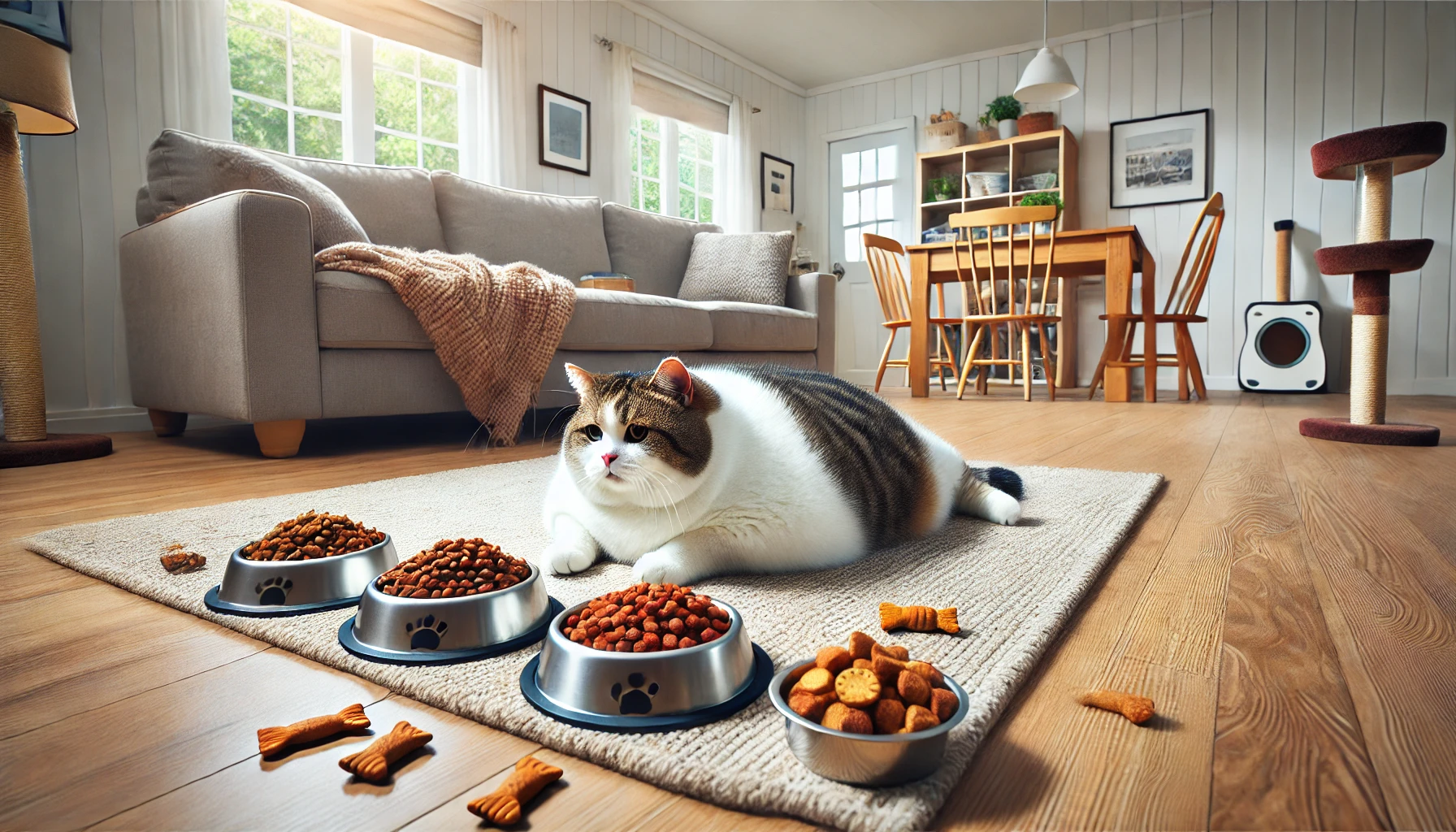
Common Causes of Cat Obesity
There can be several causes of weight gain in your cat.
These are preventable if understood well enough:
- Overfeeding: Probably the most common cause of cat obesity is overfeeding. More meals and treats than necessary build up calories quickly.
- Poor Choice of Diet: Many commercial cat foods contain high levels of carbohydrates and low levels of essential nutrients such as protein. Due to these imbalances, weight gain can easily occur since cats are obligate carnivores; their optimal diet should be high in protein.
- Lack of Physical Activity: Most indoor cats do not get enough exercise. Without regular physical activity, their bodies do not burn the energy provided through their food, leading to weight gain.
- Age: As cats age, their metabolic rate slows down. Weight gain is more likely to occur in older cats if dietary practices and exercise levels remain the same as when they were younger.
- Medical Conditions: Certain health issues, such as hypothyroidism or diabetes, can also lead to weight gain in cats.
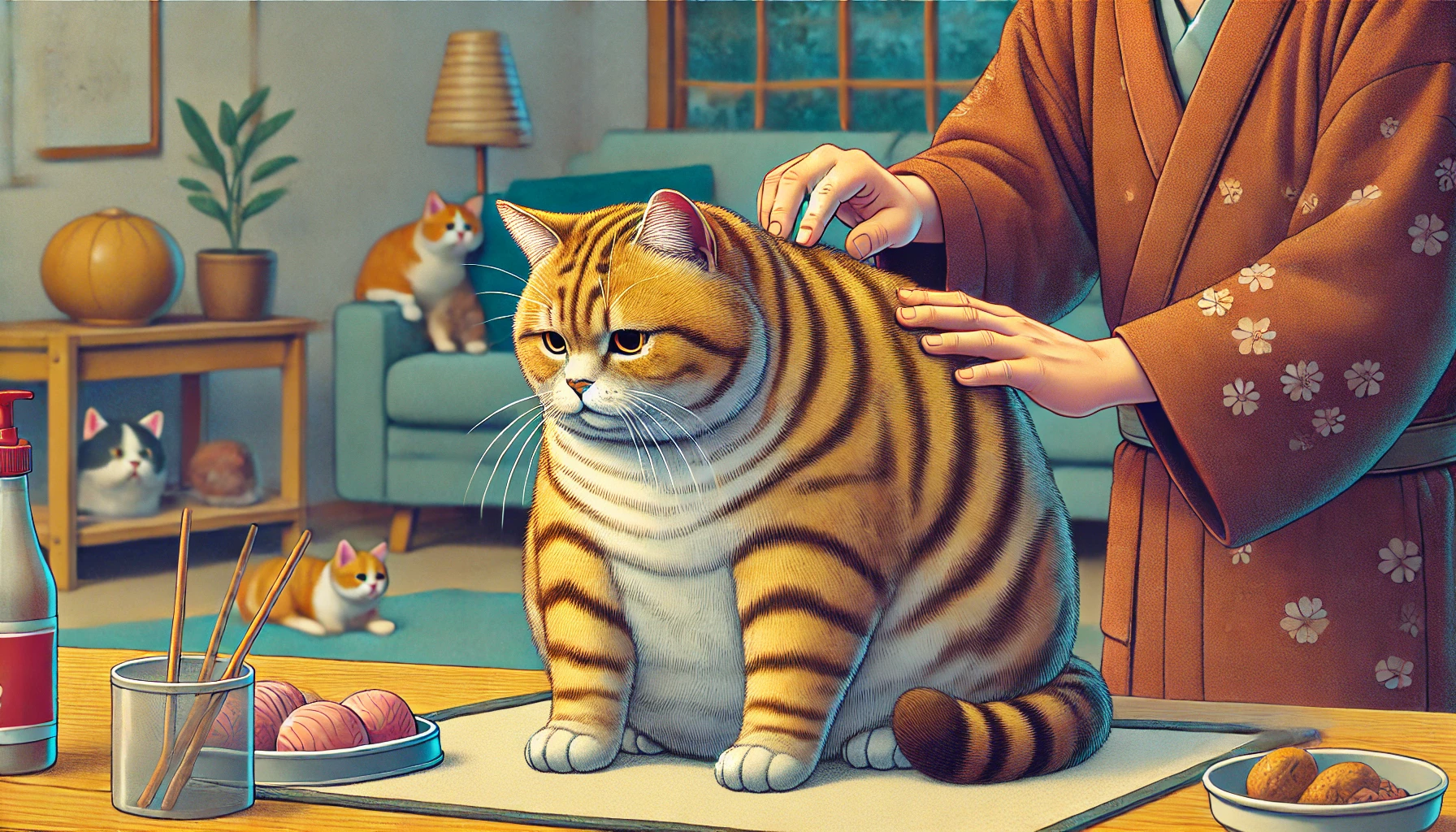
How to Recognize the Signs of Cat Obesity
Identifying obesity in cats is not as simple as it may seem.
Since different breeds are prone to having variations in body type, you should take a closer look at your cat’s condition.
Here are a few ways to tell if your cat is overweight:
- Body Shape: A healthy cat should have a visible waist when viewed from above, and you should be able to feel its ribs without excessive pressure. If these features are hard to detect, your cat may be overweight.
- Fat Deposits: Overweight cats will develop fat deposits, particularly around their abdomen and lower back.
- Lethargy: Overweight cats tend to be more sedentary and may become lethargic, showing a lack of interest or unwillingness to play. This behavior can further contribute to weight gain.
- Difficulty Grooming: Due to excess weight restricting their movement, obese cats may struggle to groom themselves as they normally would.
By becoming aware of these common causes and signs of cat obesity, you will be better equipped to monitor your cat’s weight and take active steps to keep them healthy.
Understanding the causes and risk factors of cat obesity is crucial in ensuring your cat maintains a healthy weight. This includes factors such as diet, physical activity, and age-related metabolic changes.
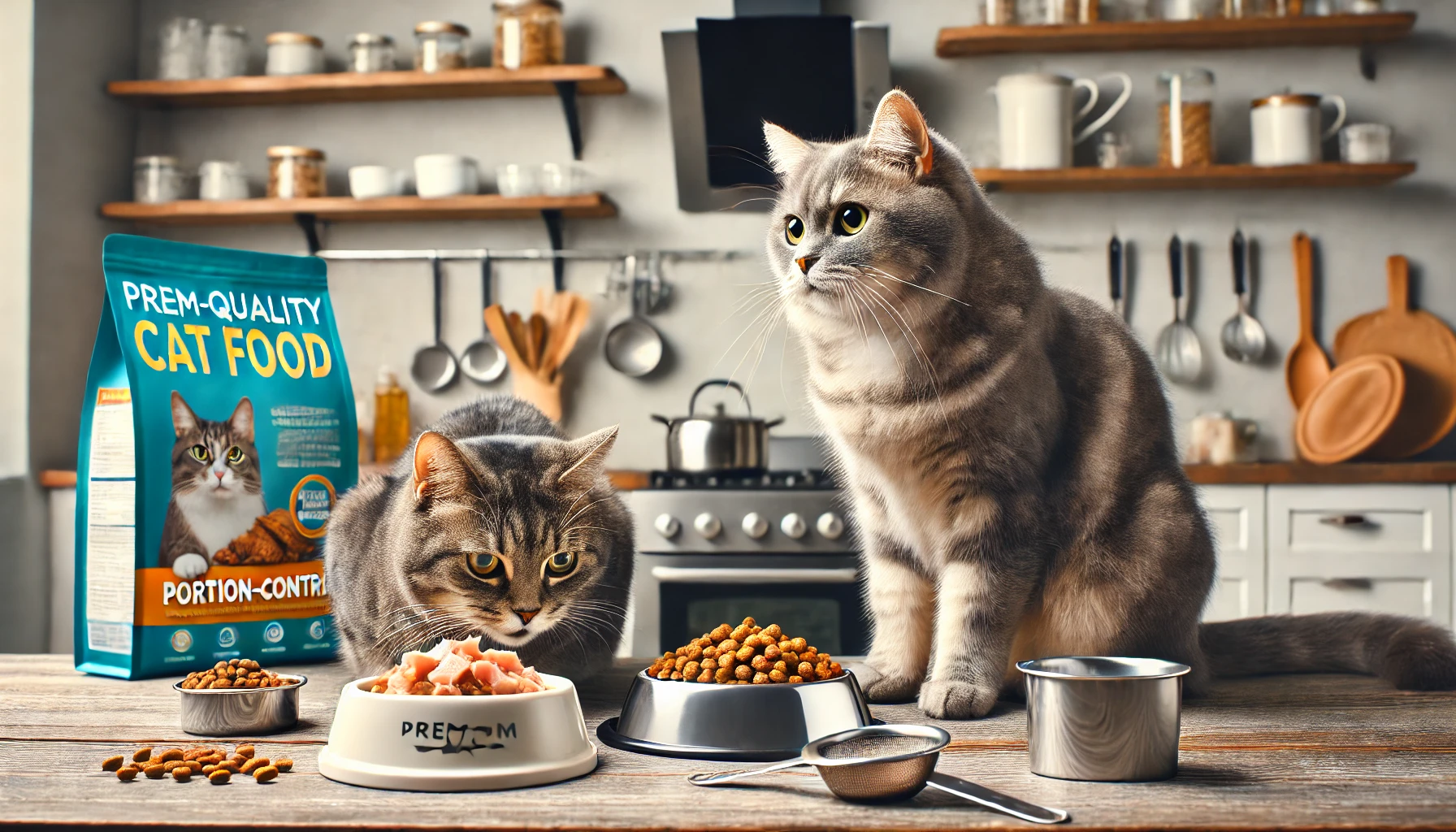
Choosing the Proper Diet to Prevent Obesity in Cats
Feeding your cat the right food is one of the major steps towards preventing cat obesity.
Cats are obligate carnivores, which means their diet should have a high content of animal-based proteins.
A proper diet helps in maintaining their muscle mass while ensuring that they do not build up unnecessary fat.
There are so many types of cat food on the market that it can be difficult to decide which ones are best for your cat’s health and weight.
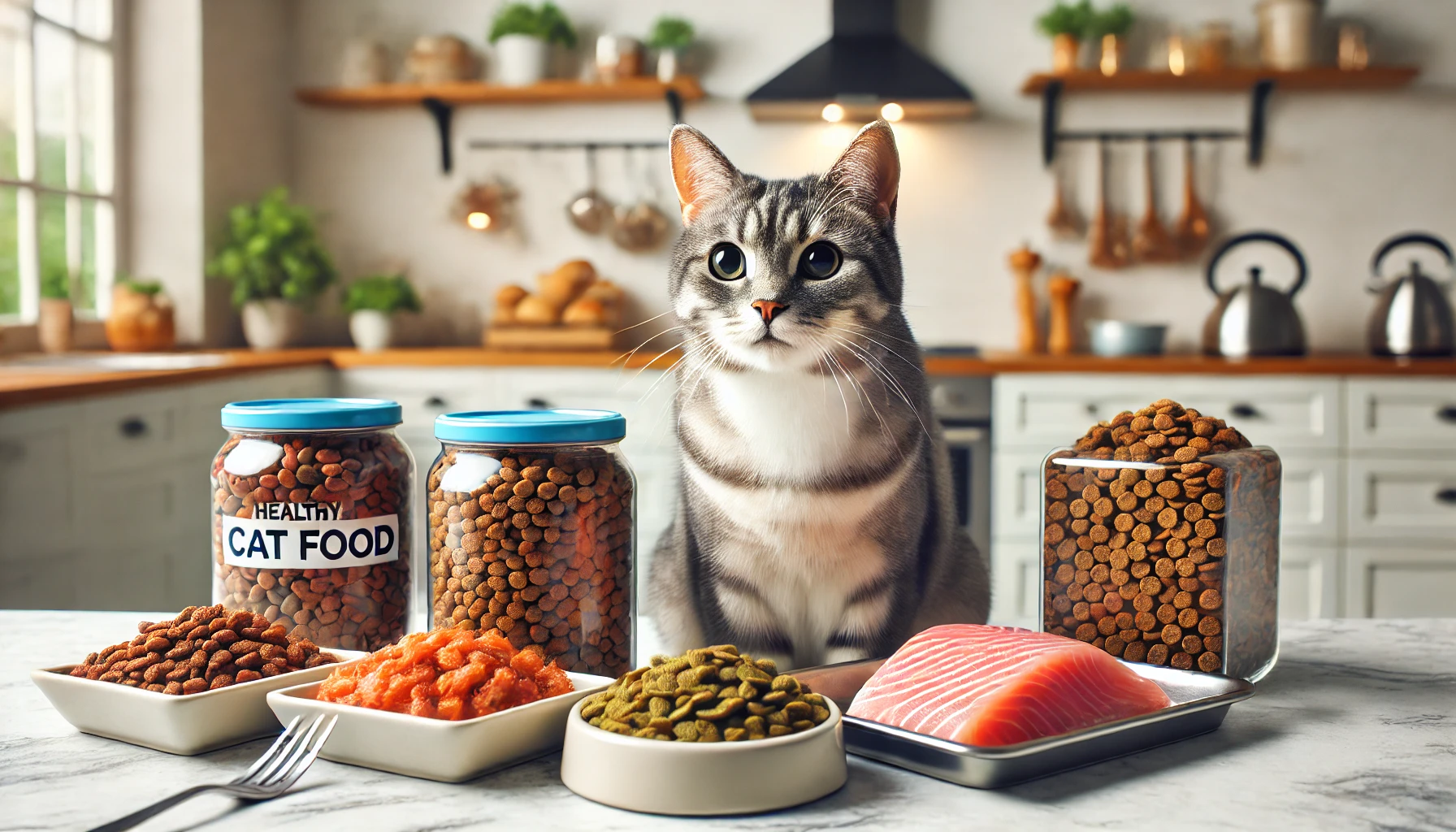
Best Types of Food for Healthy Weight
If you are trying to prevent obesity in cats, meal planning should closely consider the ingredient list and nutritional profile of the food.
The nutritional makeup that suits cats best is high in protein and low in carbohydrates.
An ideal choice for cat food would have as its first ingredient a high-quality meat such as chicken, turkey, or fish.
Avoid products with corn, soy, or large amounts of grains.
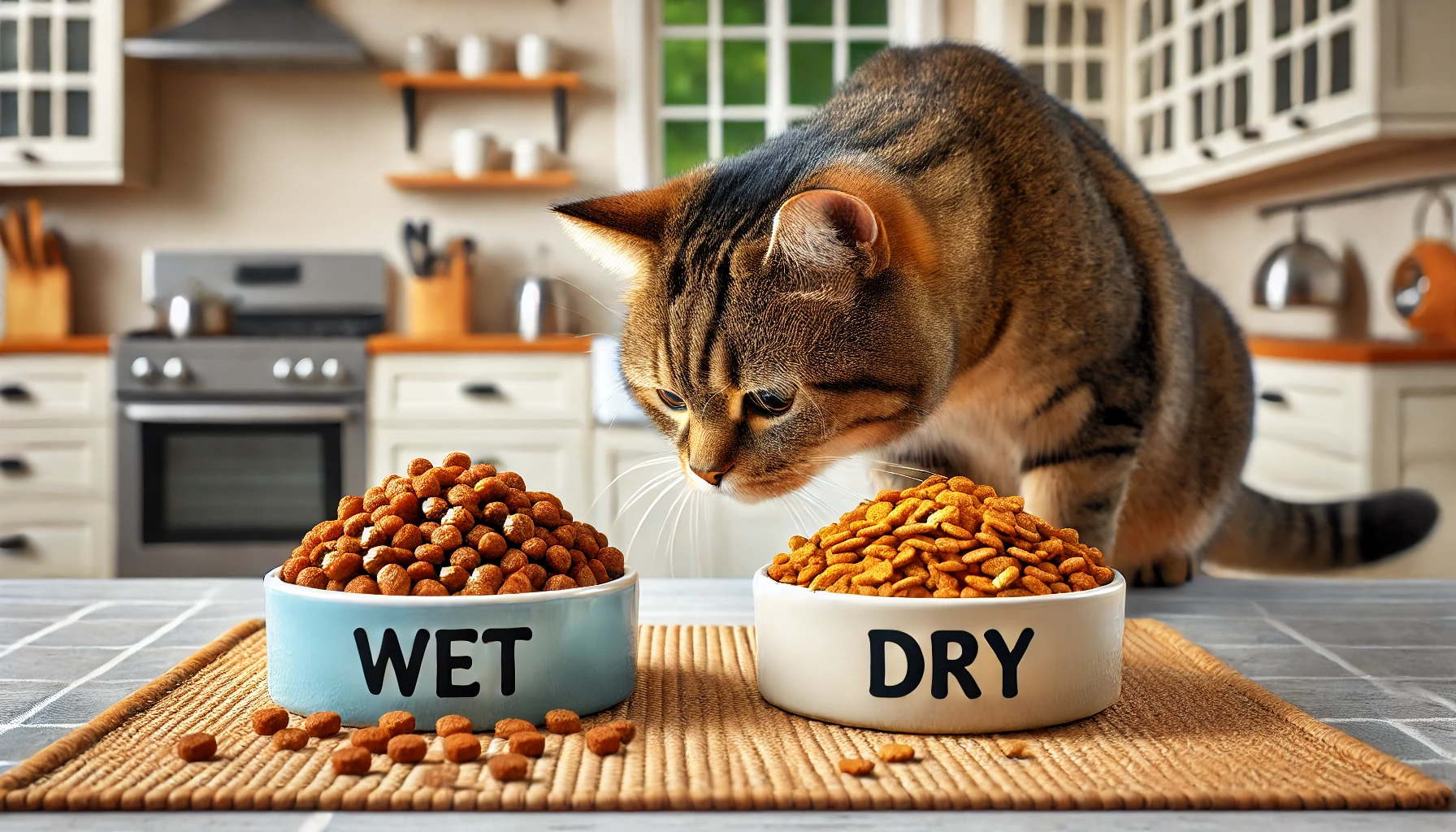
Wet Food vs. Dry Food
Wet food can help with weight control due to its moisture content and its ability to keep cats feeling full for longer.
Wet foods tend to have less carbohydrate content compared to dry kibble.
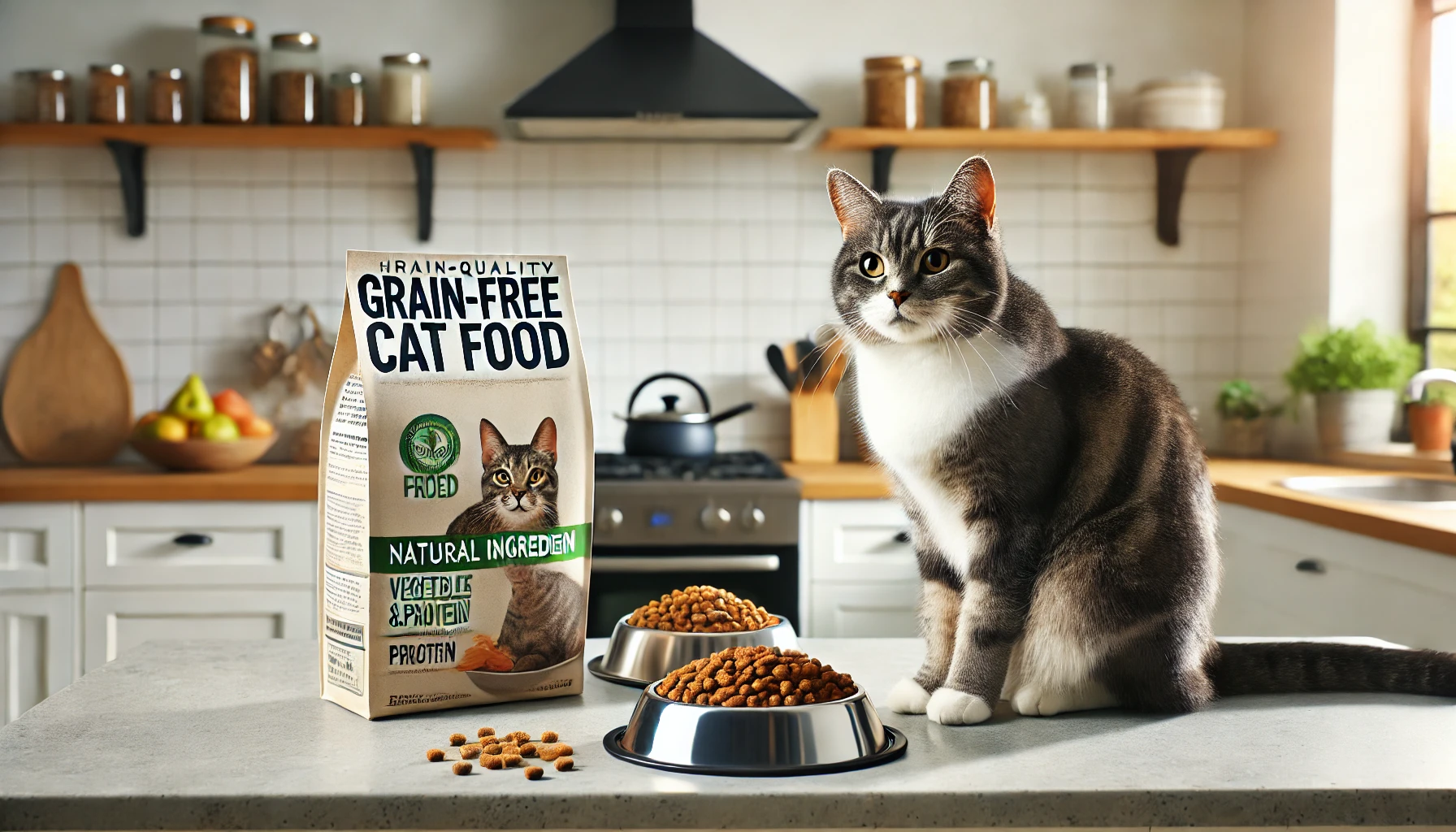
Grain-Free Options
Grain-free foods are generally lower in carbohydrates, which can help with a cat’s weight management.
However, it’s important to ensure that the food still provides all the necessary vitamins and minerals for a balanced diet.

Portion-Controlled Meals
Instead of free-feeding, giving your cat controlled portions at specific times of the day can help manage their calorie intake and prevent overeating.
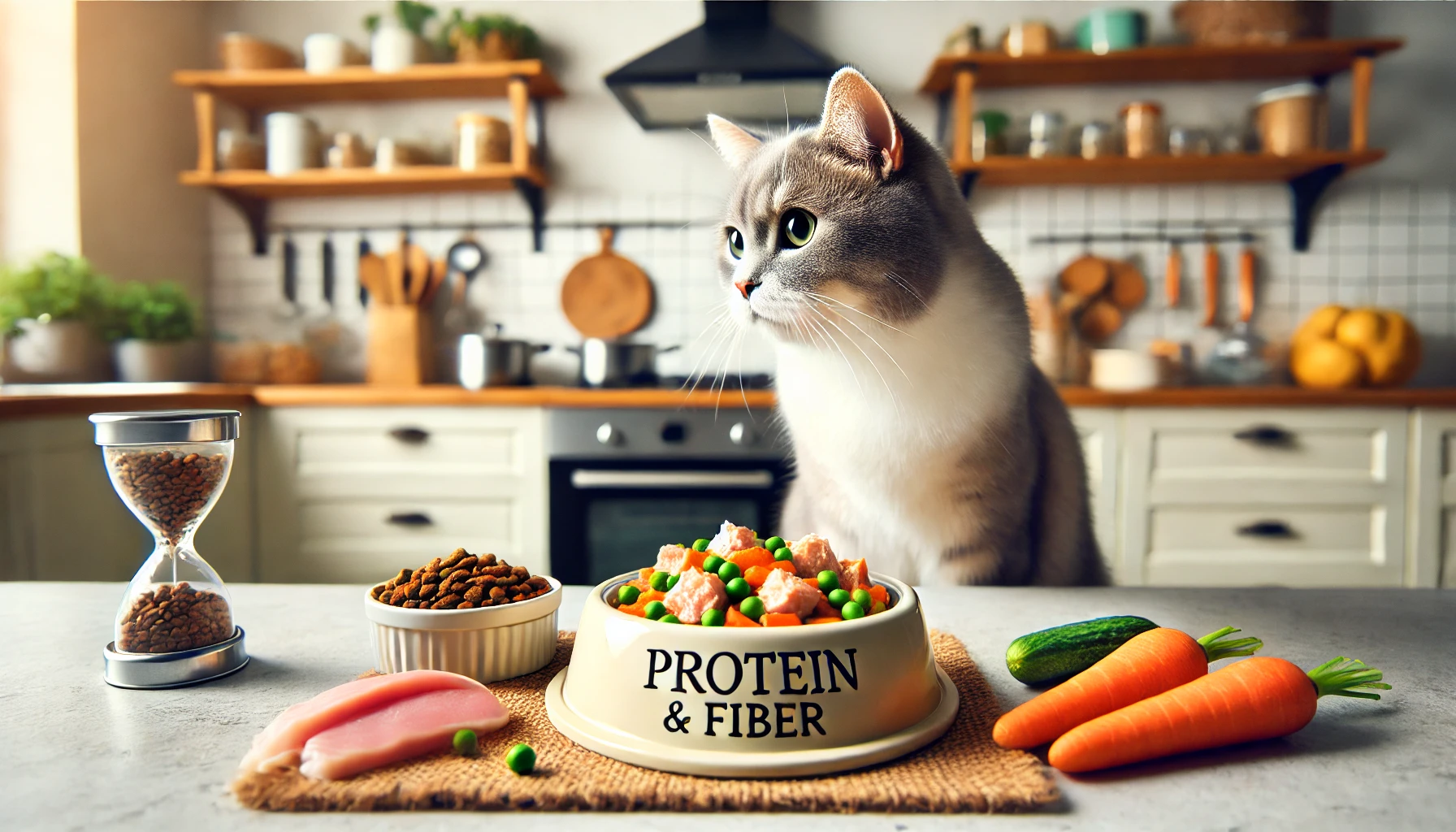
The Role of Protein and Fiber in Cat Diets
Protein plays a vital role in preventing cat obesity as it supports lean muscle mass and helps cats feel full after eating.
The protein content in cat food should be around 30-40%.
Premium animal-based proteins such as chicken, turkey, and fish are especially important.
While fiber is not as essential for cats as it is for other animals, it can aid digestion and help with weight management by promoting a sense of fullness.
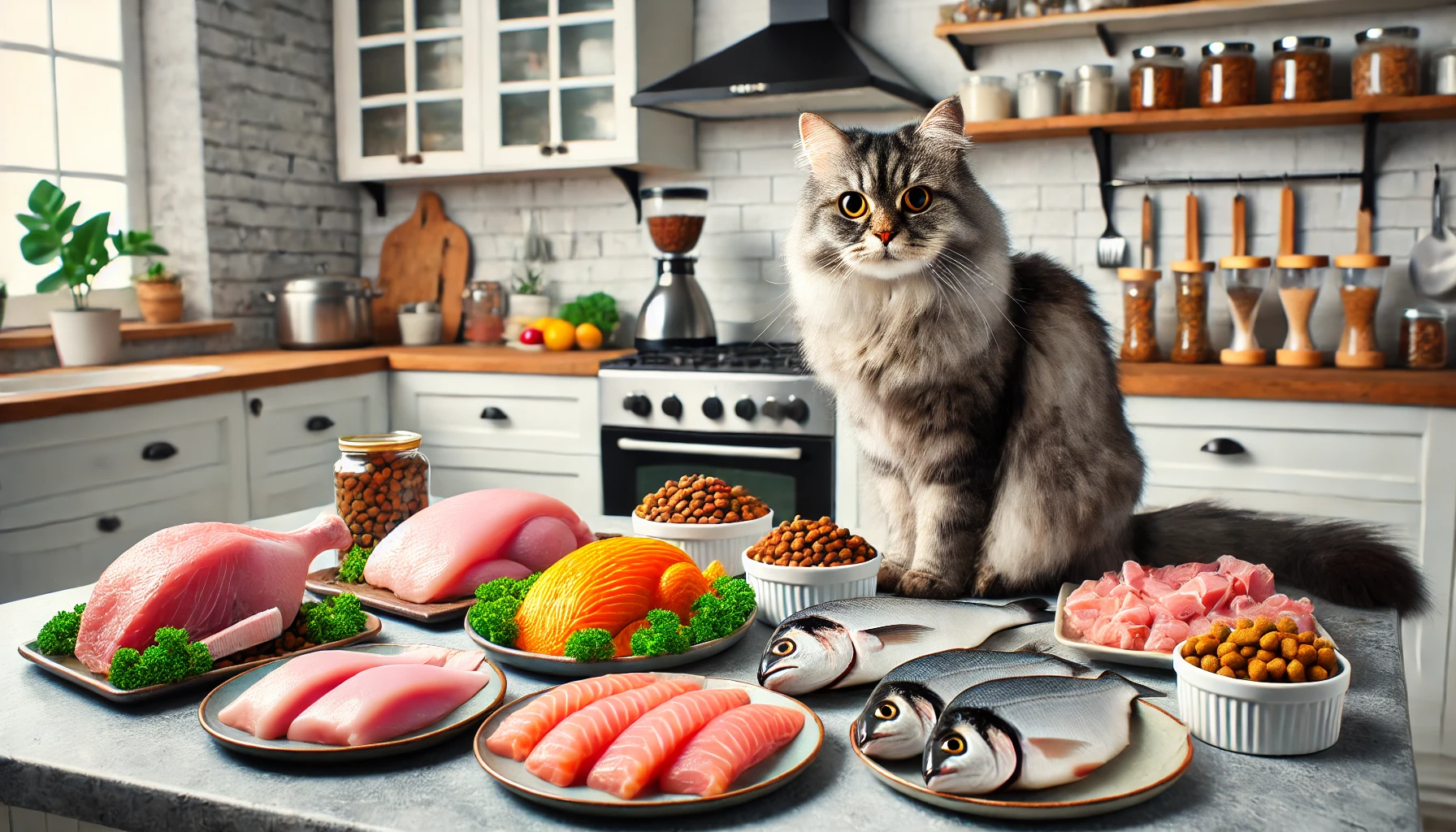
Animal-Based Proteins
Animal-based proteins keep cats lean and active because their bodies are designed to digest and utilize these nutrients efficiently.
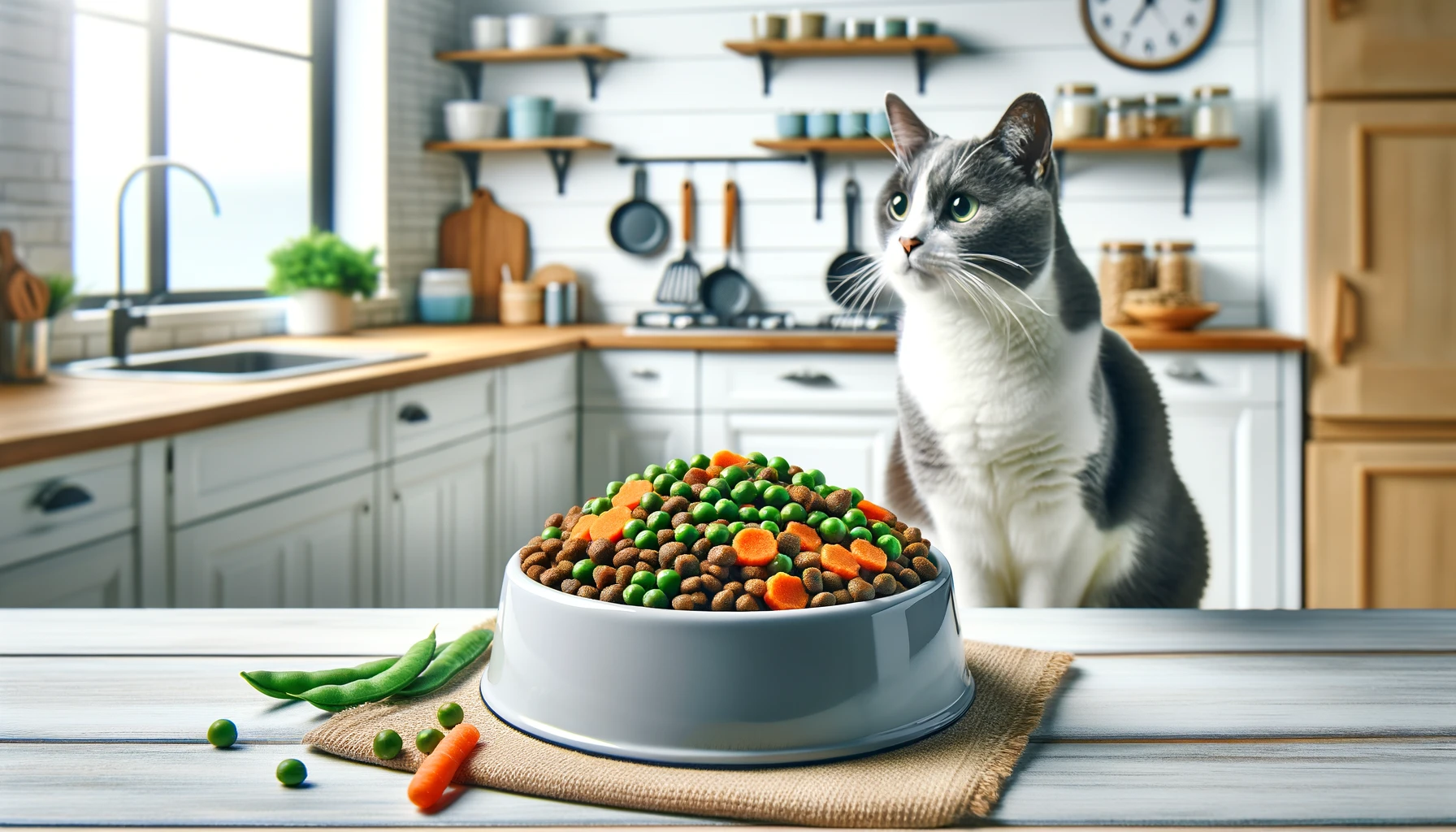
Moderate Fiber
Some cat foods include added fiber, which helps with digestion and reduces the risk of cat obesity by making cats feel full for longer.
However, too much fiber can interfere with nutrient absorption, so it’s important to maintain a balanced amount in your cat’s diet.
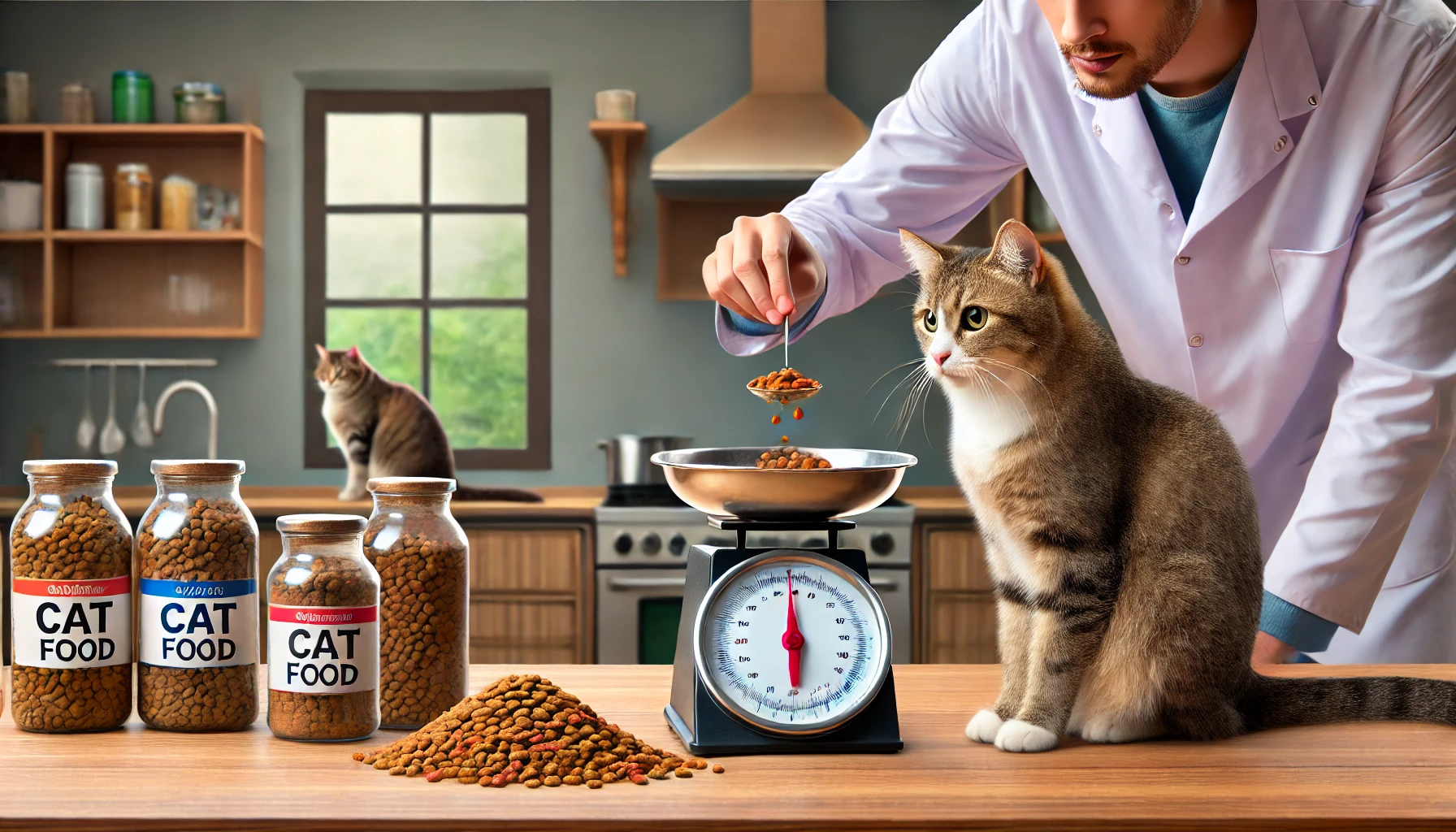
How to Avoid Overfeeding and Monitor Portions
Overfeeding is a common cause of cat obesity.
It’s tempting to give extra treats or slightly larger portions, but these extra calories can add up quickly.
Feeding guidelines on commercial cat food packages provide a general idea of how much to feed your cat based on their weight and activity level.
However, it’s important to adjust these amounts according to your cat’s specific needs.
Indoor cats, for example, tend to need fewer calories than more active outdoor cats.
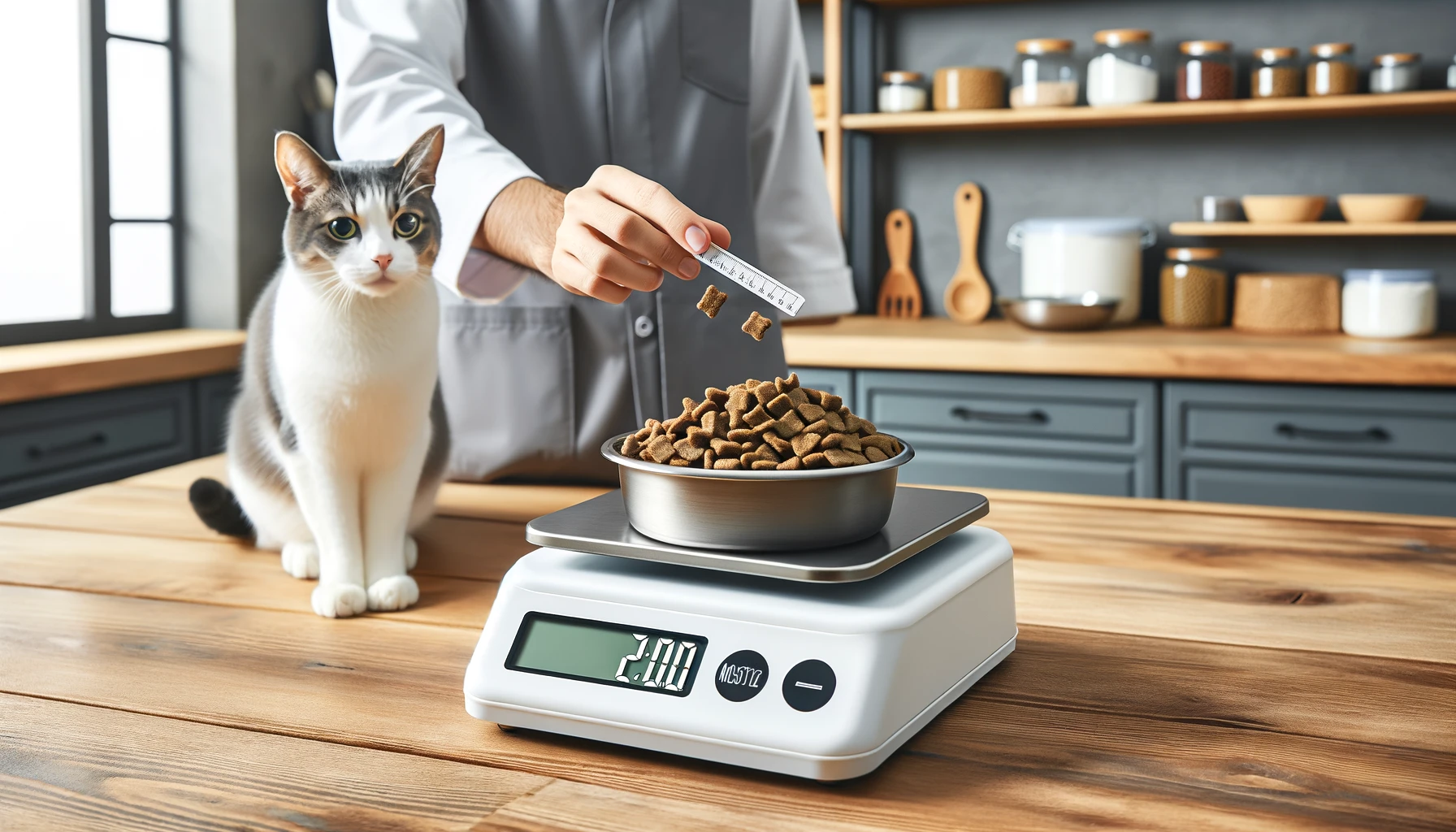
Weigh Food Portions
Using a kitchen scale to weigh your cat’s food portions will help prevent overfeeding and ensure that you’re providing the correct amount.
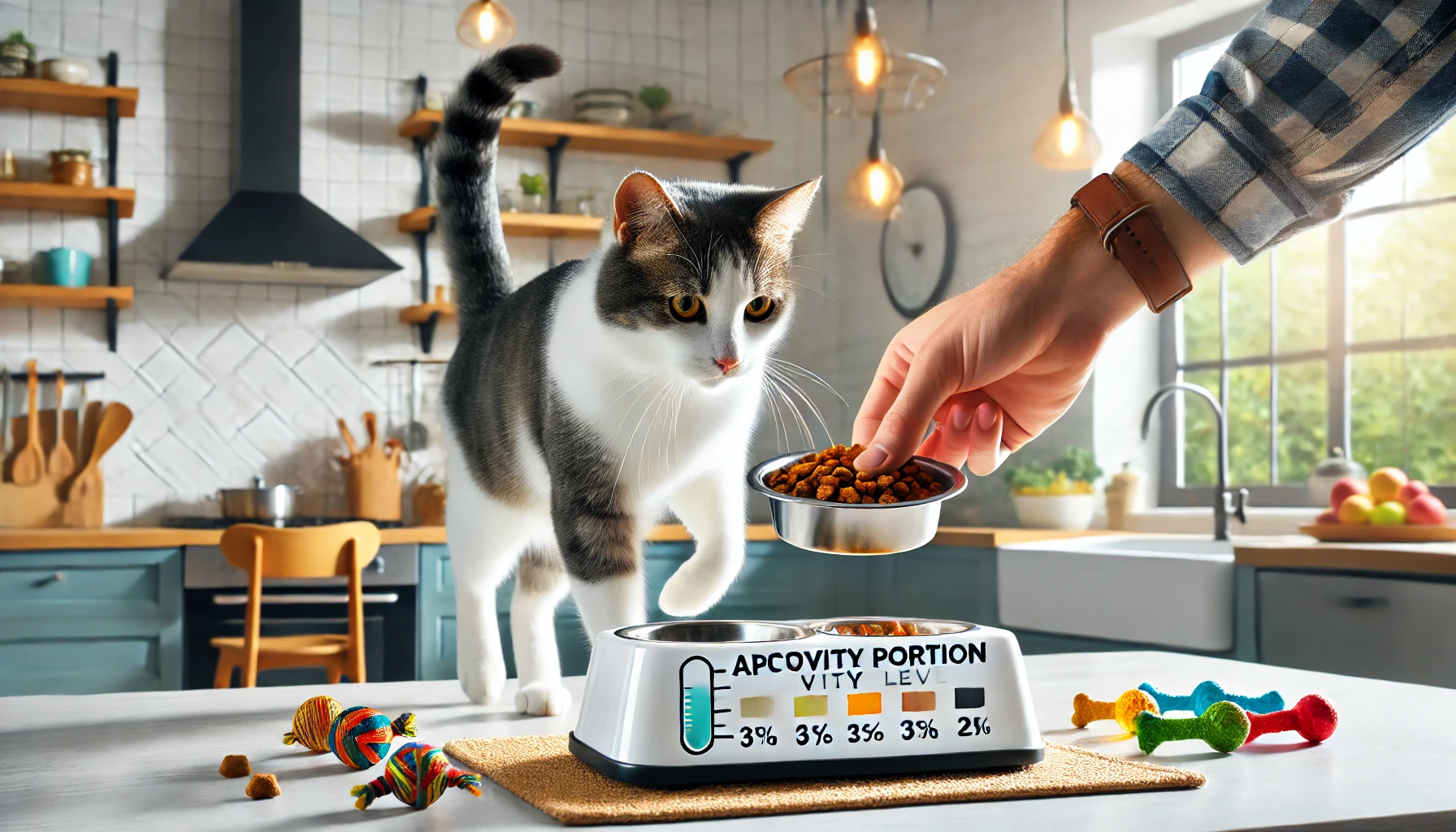
Feed by Activity Level
Adjust portion sizes based on your cat’s physical activity.
More active cats will need a higher caloric intake, while less active cats require fewer calories.
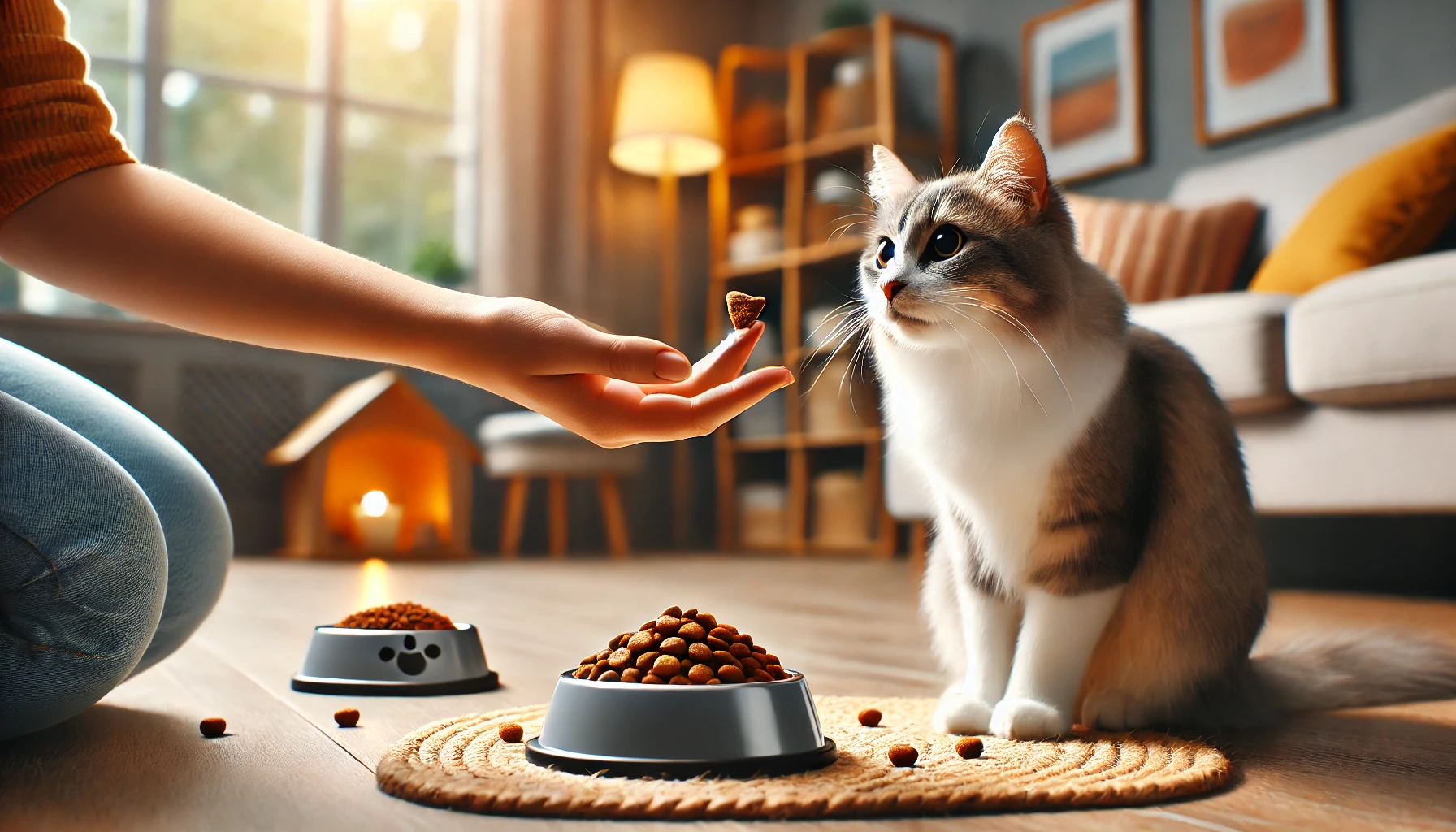
Limit Treats
Treats should make up no more than 10% of your cat’s daily calorie intake.
Choose healthy, low-calorie treats to avoid contributing to weight gain.
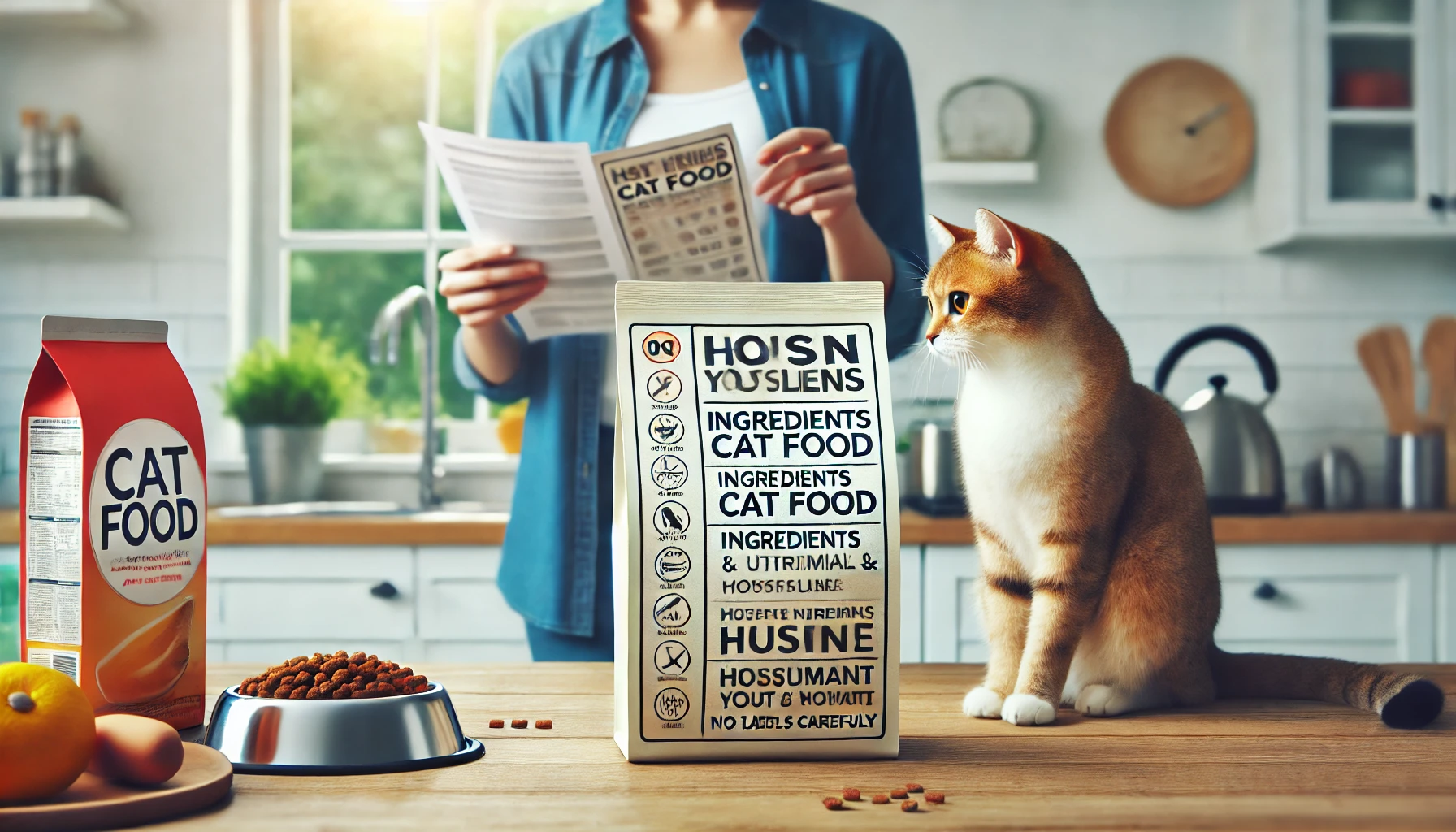
Understanding Cat Food Labels and Ingredients
When selecting a diet to prevent cat obesity, it’s important to read cat food labels carefully.
Look for products that clearly indicate the percentage of protein, fat, and carbohydrates.
Avoid foods with vague ingredients like “meat by-products” or “animal fat,” as these could be low-quality sources of nutrition.
Also, check for artificial preservatives, colors, or flavors, which can negatively impact your cat’s overall health.
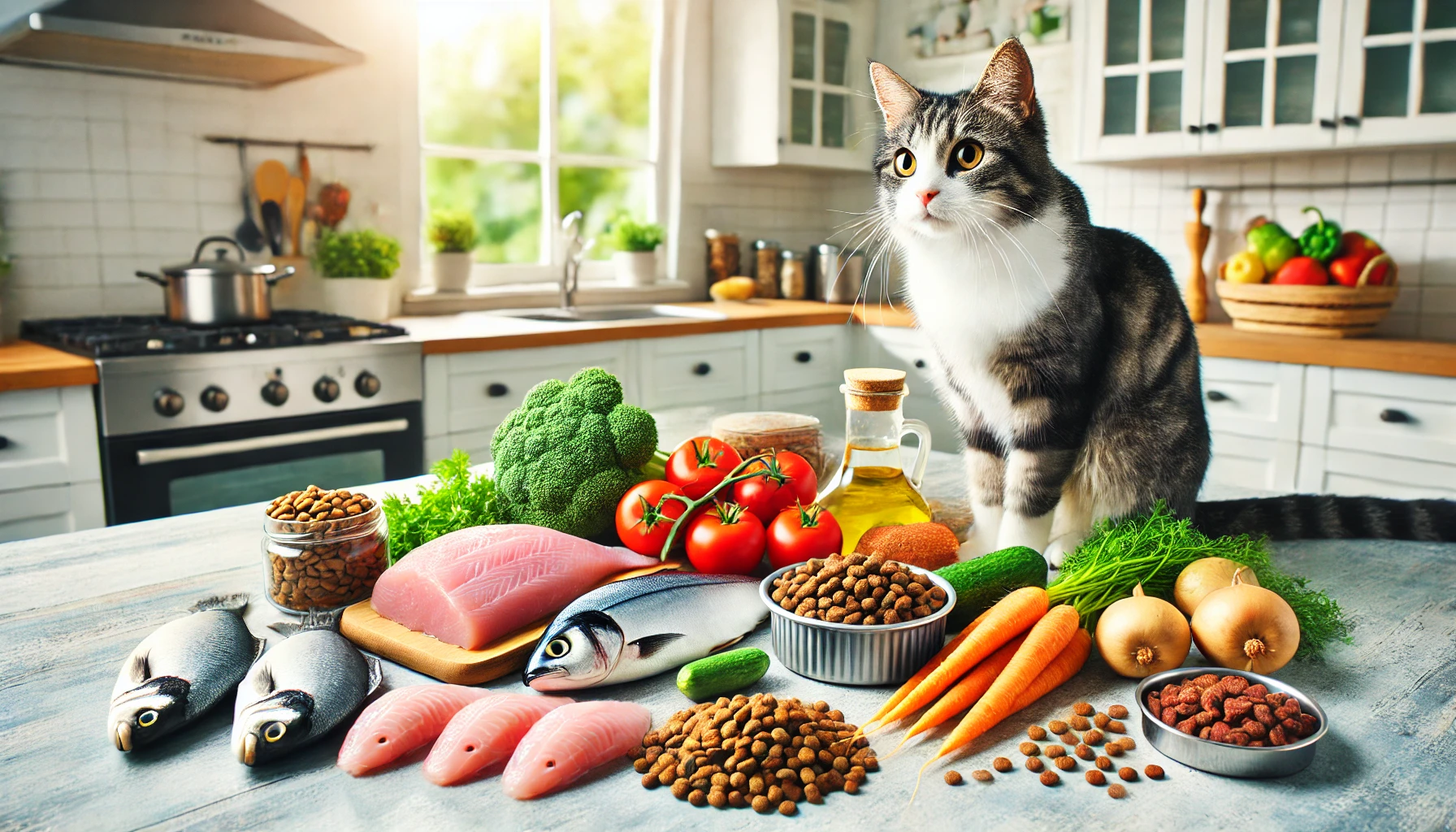
Top Ingredients
- First Ingredient: The first ingredient should be a premium protein source like chicken, turkey, or salmon.
- Carbohydrate Content: Cats do not require many carbohydrates, so choosing a low-carb food will help prevent obesity in cats.
- Avoid Fillers: Stay away from foods with excessive fillers like corn, wheat, or soy, as they provide little nutritional value and can contribute to cat obesity.
Paying attention to the right food and portioning can go a long way in minimizing the risks associated with cat obesity and will keep your feline friend healthy and happy.
Choosing a diet high in animal-based proteins and low in carbohydrates can prevent obesity in cats. It’s essential to understand the nutritional needs of cats to make informed choices about their diet.
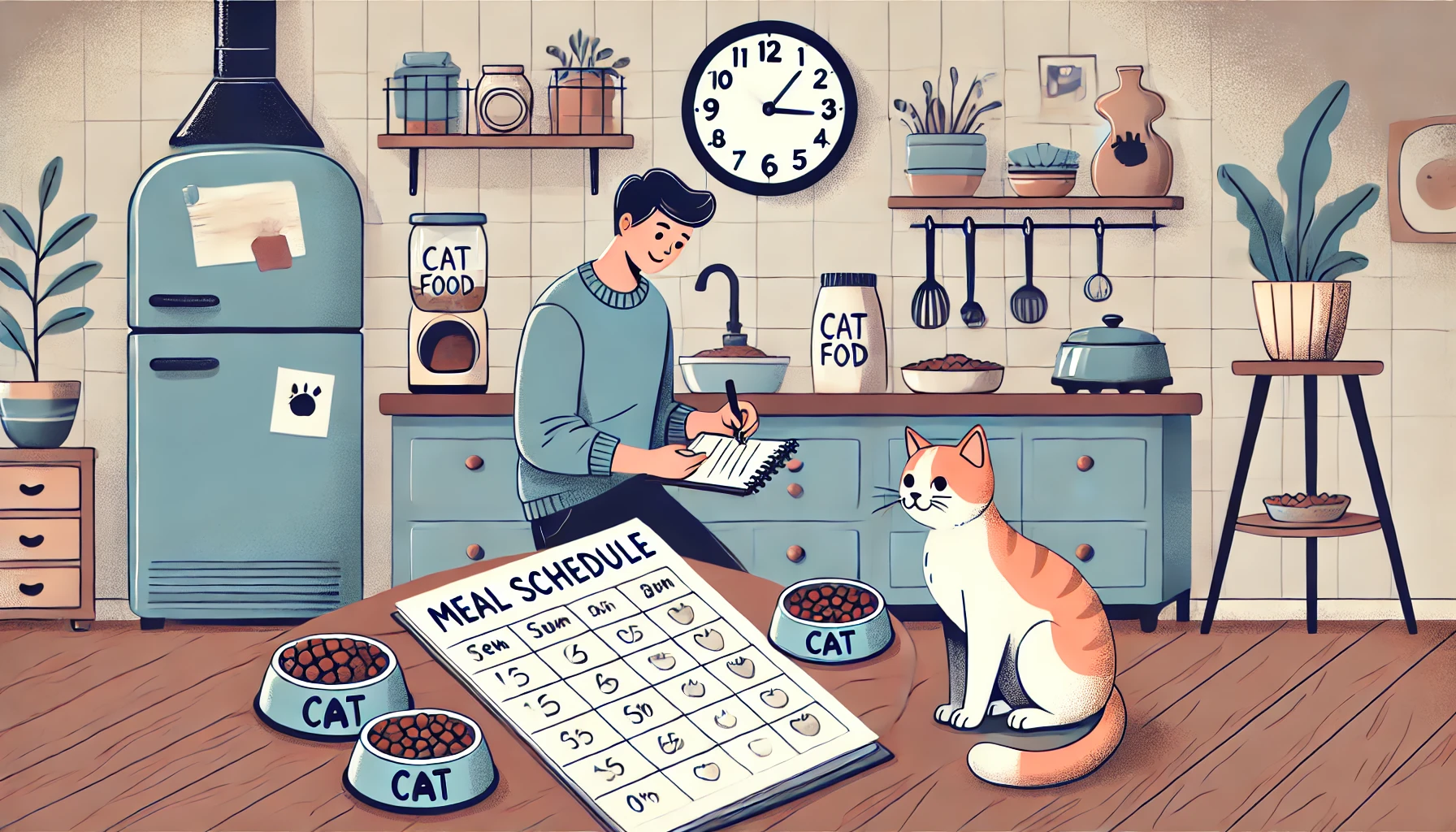
Feline Meal Planning and Feeding Schedules
Proper meal planning and feeding schedules are significant in the prevention of obesity in cats.
Just like humans, cats need regularity in their meals to maintain good health and a healthy weight.
The secret to your cat’s weight management isn’t just what you feed them, but how and when you feed them.
A scheduled feeding pattern controls the amount of calories they intake and prevents overeating.
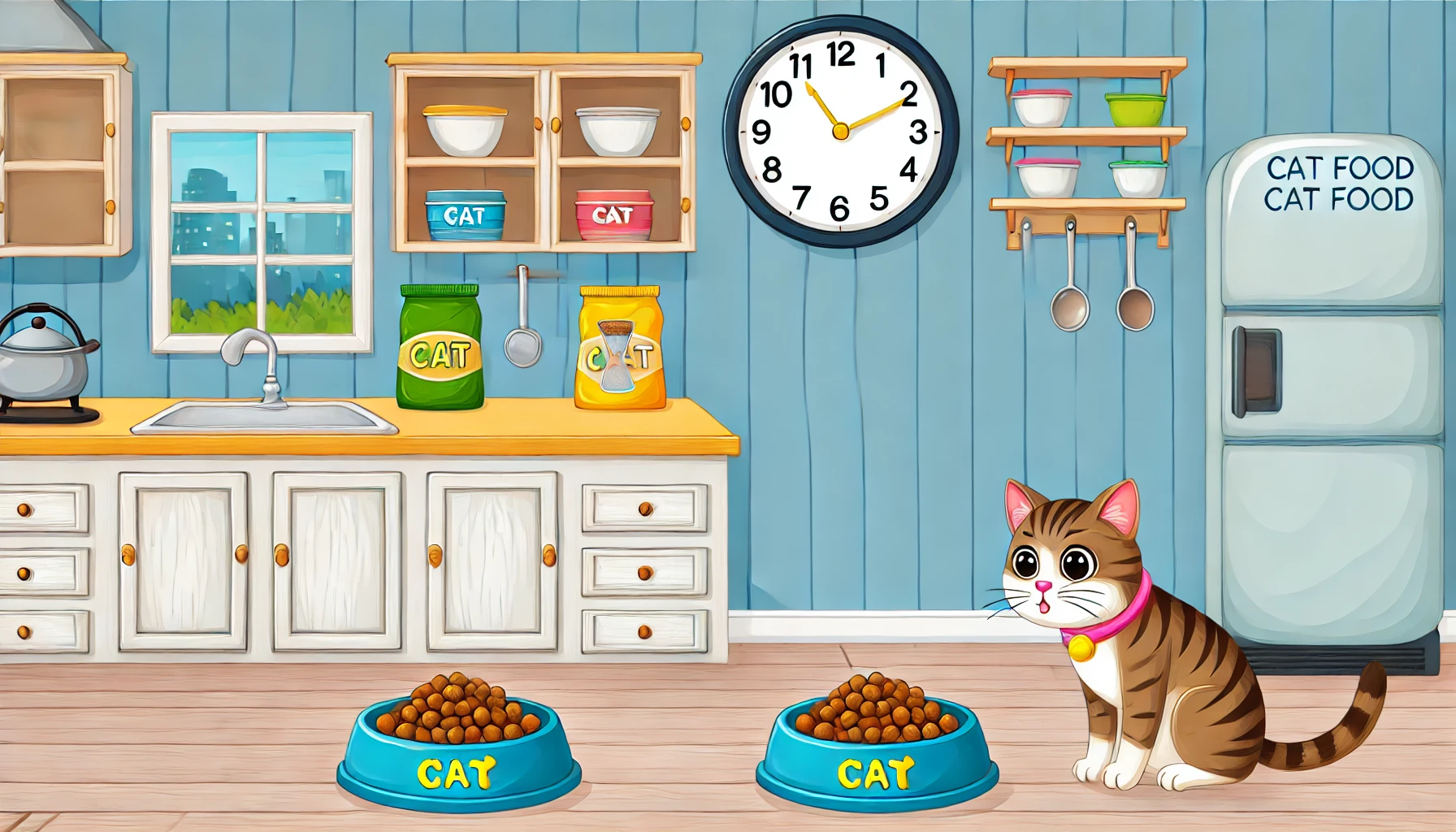
Importance of Consistent Feeding Times
Feeding cats should be done in a routine manner.
Establishing consistent feeding times is crucial for digestion and metabolism.
If meals are given to cats at the same time every day, it helps their bodies process nutrients more efficiently, aiding in the prevention of cat obesity.
- Set Regular Meal Times: Feed your cat at the same times each day so your cat can digest its food properly and avoid begging for food at awkward times.
- Steer Clear of Free-Feeding: Free-feeding, which involves leaving food out all day, can lead to overeating. Instead, portion meals at set times to regulate their calorie intake.
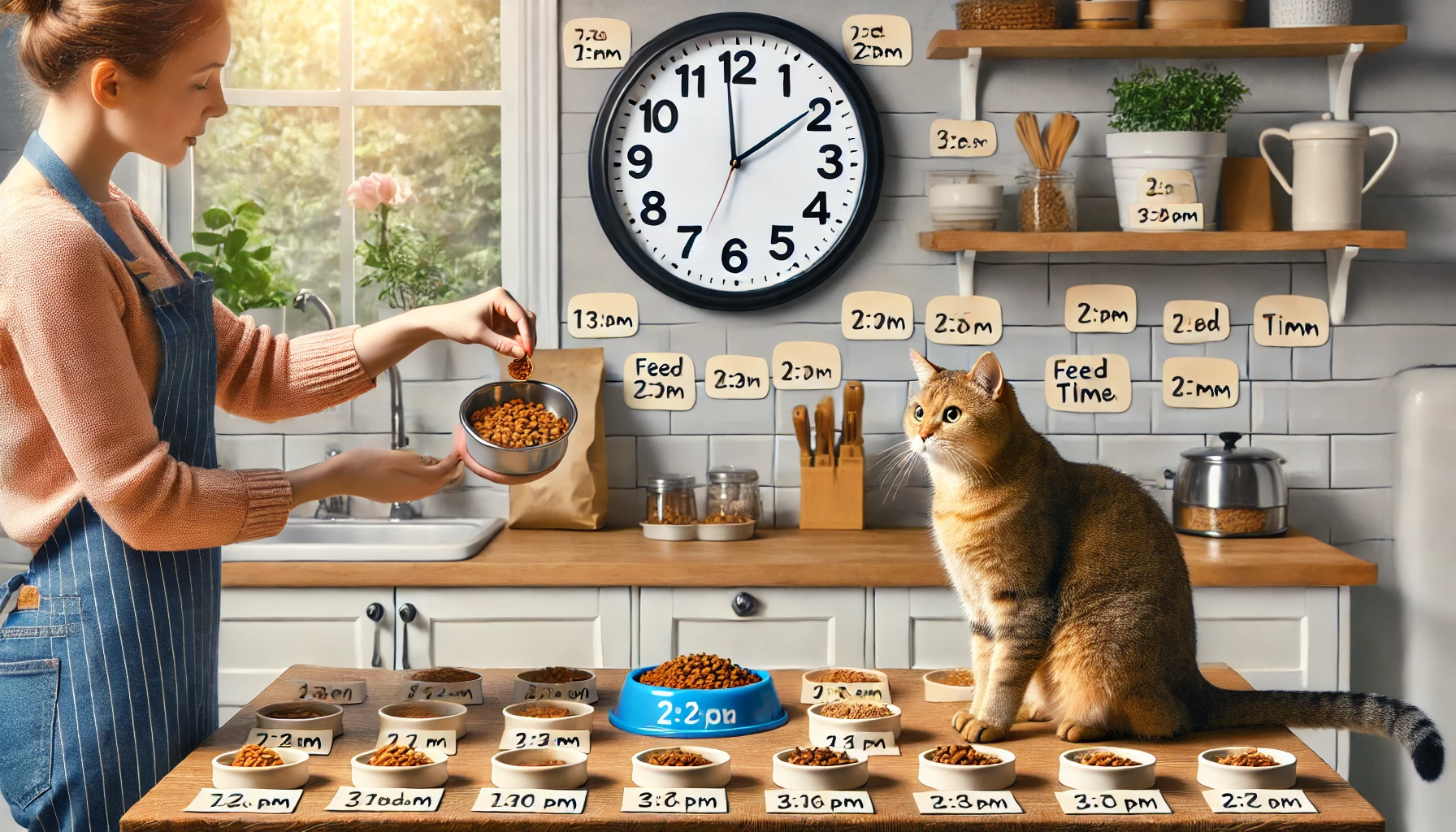
How Often Should You Feed Your Cat?
The frequency of feeding depends on your cat’s age, health, and activity level.
Most adult cats do best with two meals a day, though kittens require more frequent feedings due to their rapid growth.
Dividing the daily food into two or three meals for an adult cat helps prevent overeating and supports weight control.
- Kittens: Kittens, being in a stage of fast growth and development, generally need to eat 3-4 times daily.
- Adult Cats: Feeding adult cats 2-3 times a day helps maintain a healthy weight and prevents obesity in cats.
- Senior Cats: Older cats may benefit from smaller, more frequent meals due to their slower metabolism.
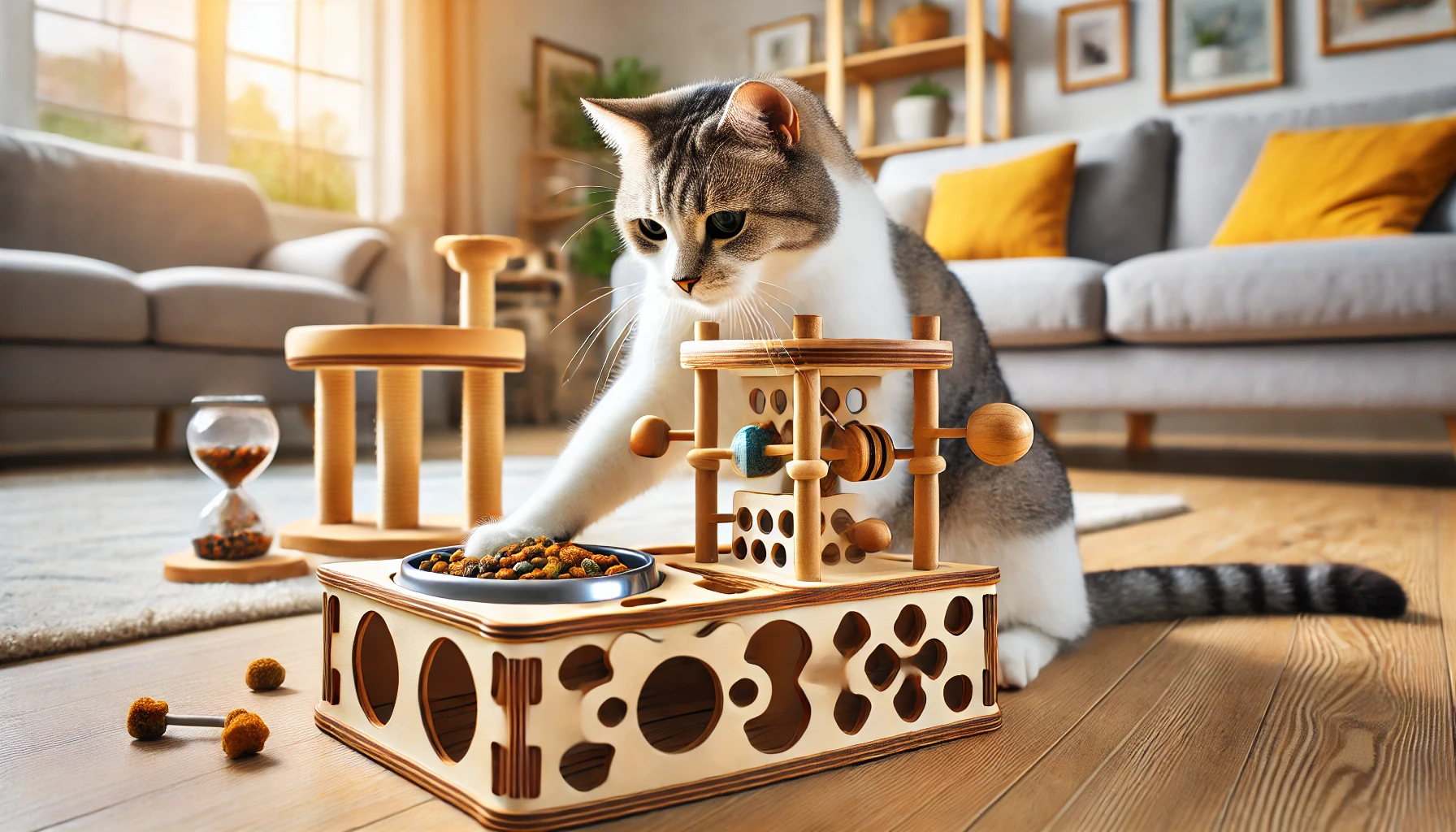
Using Puzzle Feeders and Slow-Feed Bowls
Puzzle feeders and slow-feed bowls are excellent tools for preventing cat obesity.
These devices slow down eating by encouraging cats to work for their food, providing both mental stimulation and reducing the risk of overeating.
Puzzle feeders also mimic natural hunting behaviors, keeping your cat active and engaged during mealtimes.
- Puzzle Feeders: Interactive toys that dispense small amounts of food as the cat plays with them, mimicking natural hunting behaviors.
- Slow-Feed Bowls: Designed with ridges or obstacles that make it harder for cats to eat quickly, helping them feel full on less food.
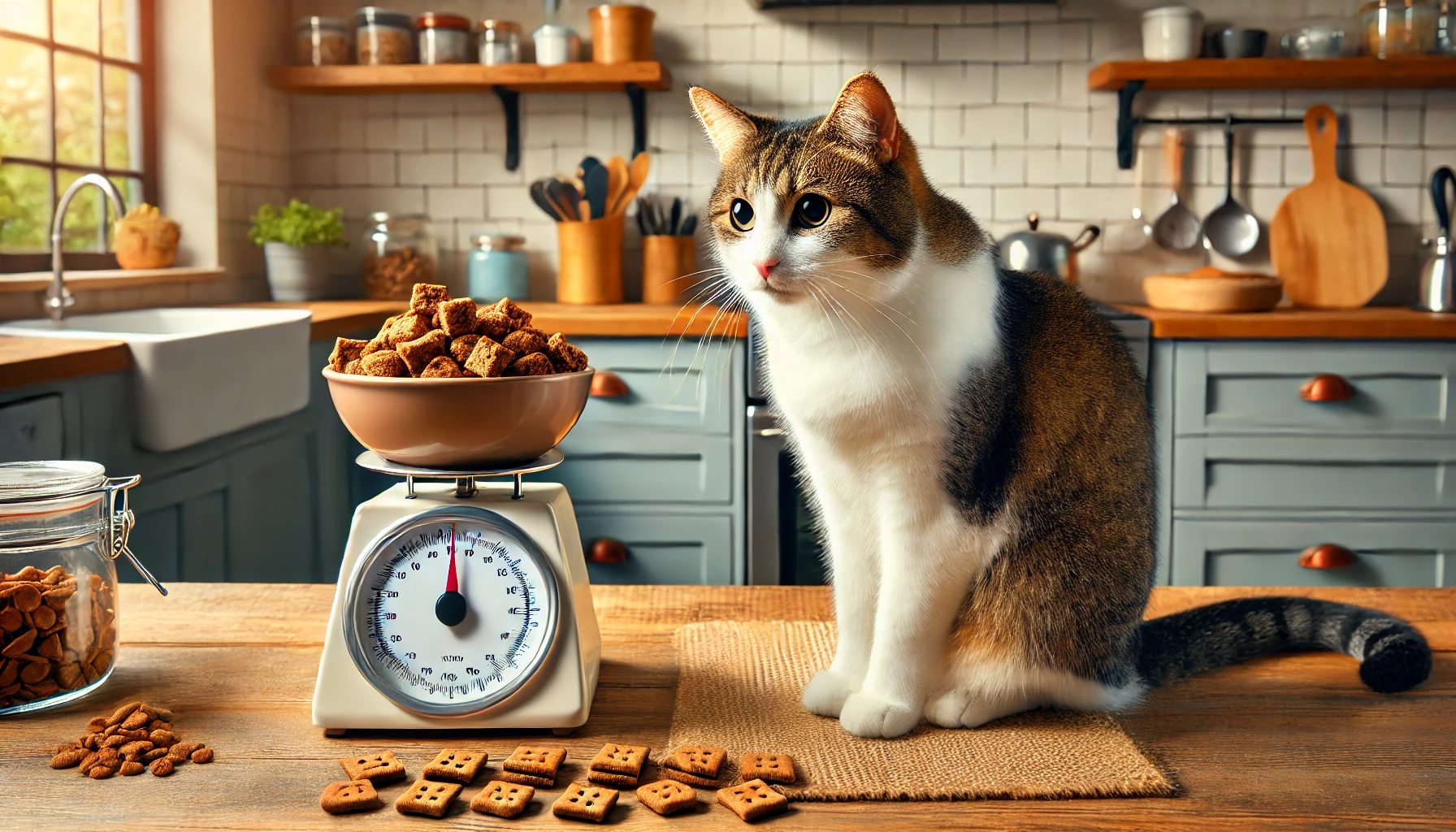
Treats and Snacks: How Much Is Too Much?
Treats are a fun reward for cats, but overindulgence can lead to obesity in cats.
Treats should make up no more than 10% of their daily calorie intake.
It’s important to choose healthy, low-calorie treats and avoid giving them too frequently.
- Healthy Treat Options: Choose low-calorie, natural treats such as freeze-dried meats or small portions of lean protein.
- Frequency of Treats: Offer treats sparingly and use them to reward good behavior, rather than as part of their regular diet.
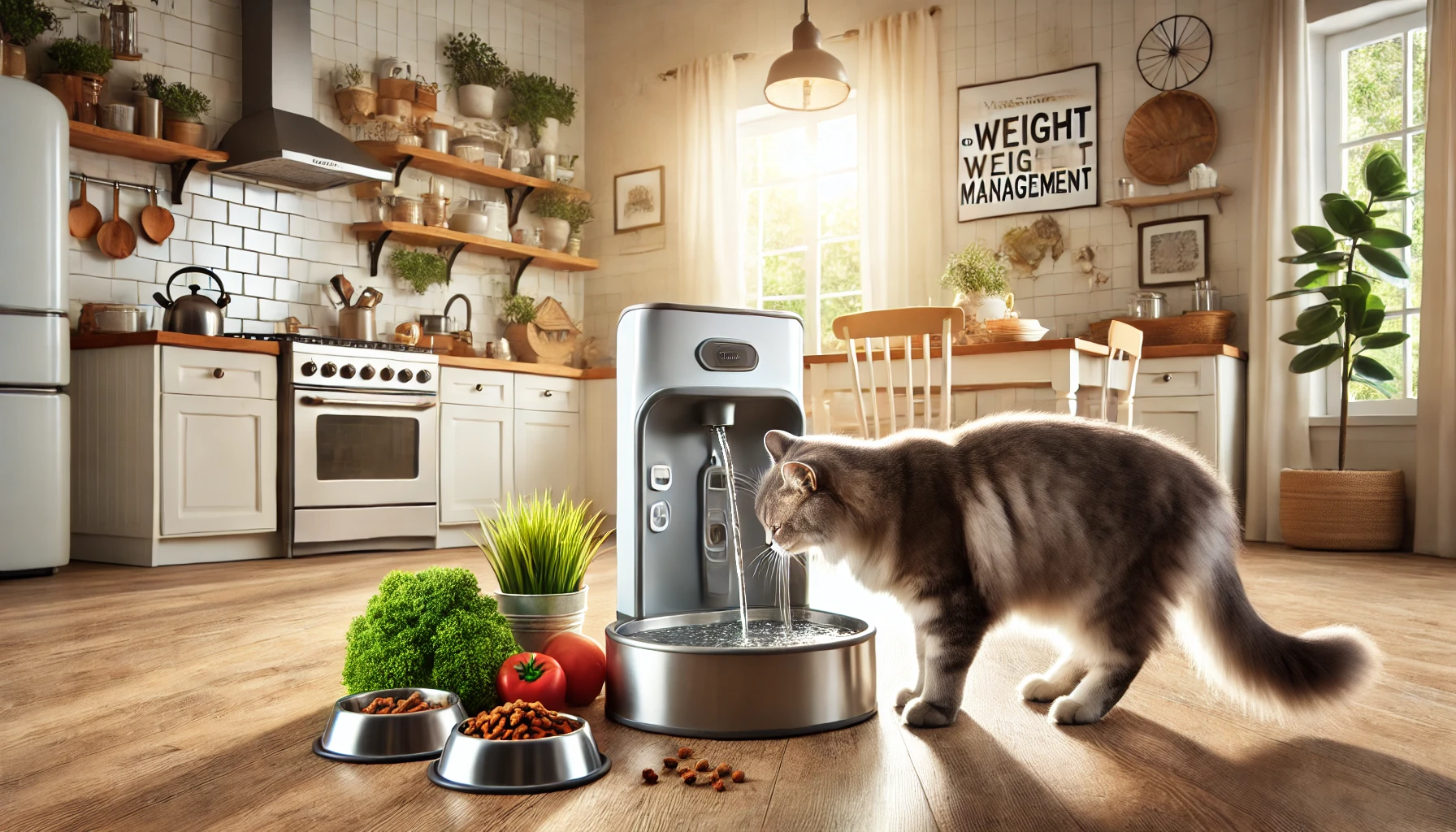
Hydration and Its Role in Weight Management
Hydration is often overlooked in discussions of cat obesity, but it plays an important role in overall health and weight management.
Cats that are well-hydrated tend to eat less, as thirst is sometimes mistaken for hunger.
Wet food can help increase water intake, but fresh water should always be available.
- Wet Food Benefits: Wet food contains more water, helping to keep your cat hydrated and feeling full for longer.
- Provide Fresh Water: Ensure your cat has access to fresh water at all times. A water fountain may encourage more drinking.
By following a structured meal routine and maintaining consistent feeding times, you can help prevent cat obesity and keep your cat healthy and active.
Establishing a consistent feeding schedule helps regulate calorie intake and prevents overeating, which can lead to cat obesity.
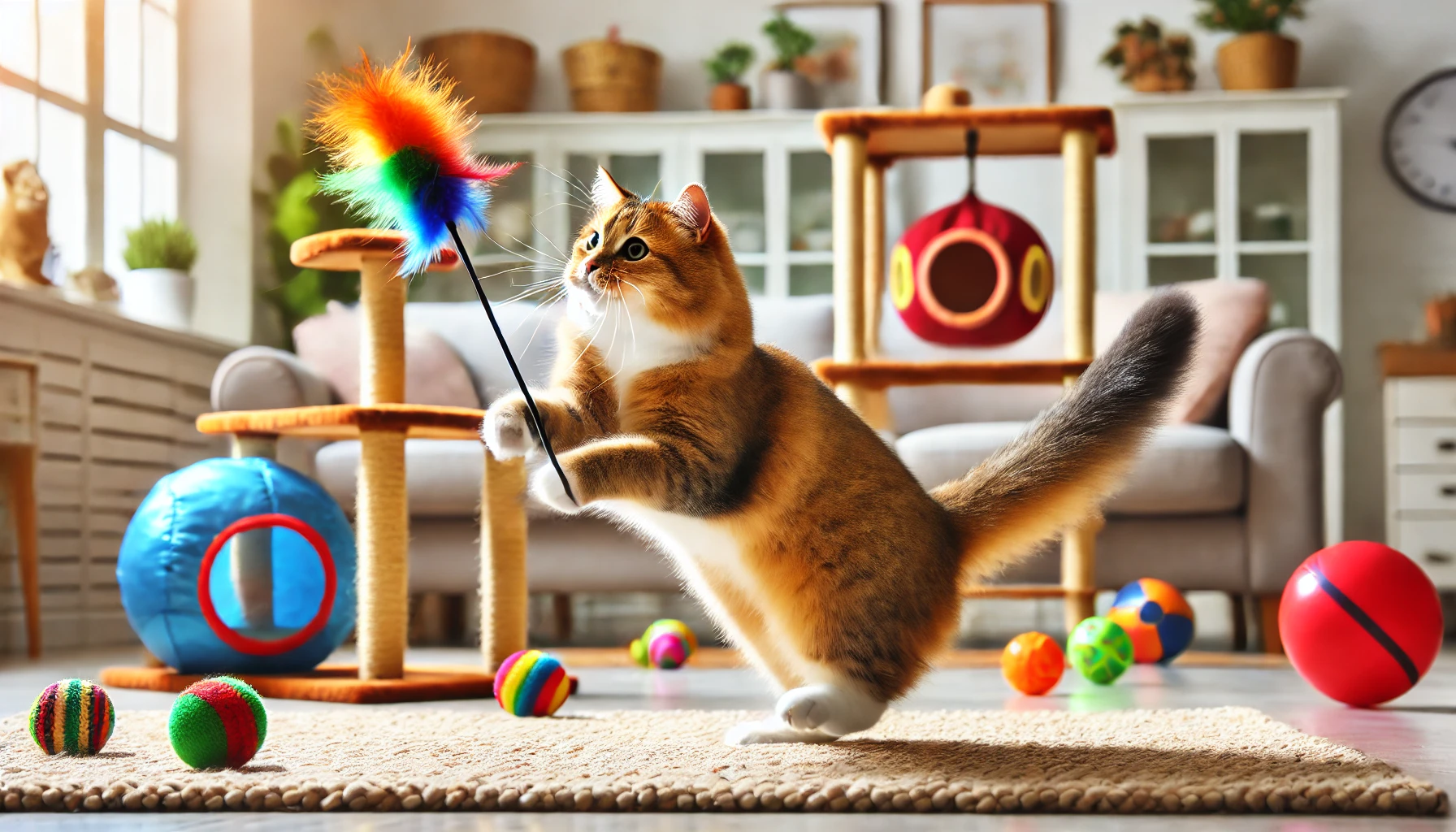
Exercises and Activities to Avoid Obesity in Cats
Besides a proper diet, regular exercises and physical activities will also help prevent feline obesity.
Cats naturally have a propensity to be playful and curious animals, but indoor cats especially don’t usually get the needed level of activity to keep them healthy.
Engaging your cat in regular play sessions and providing opportunities for physical activity goes a long way in controlling your cat’s weight and keeping them mentally stimulated.
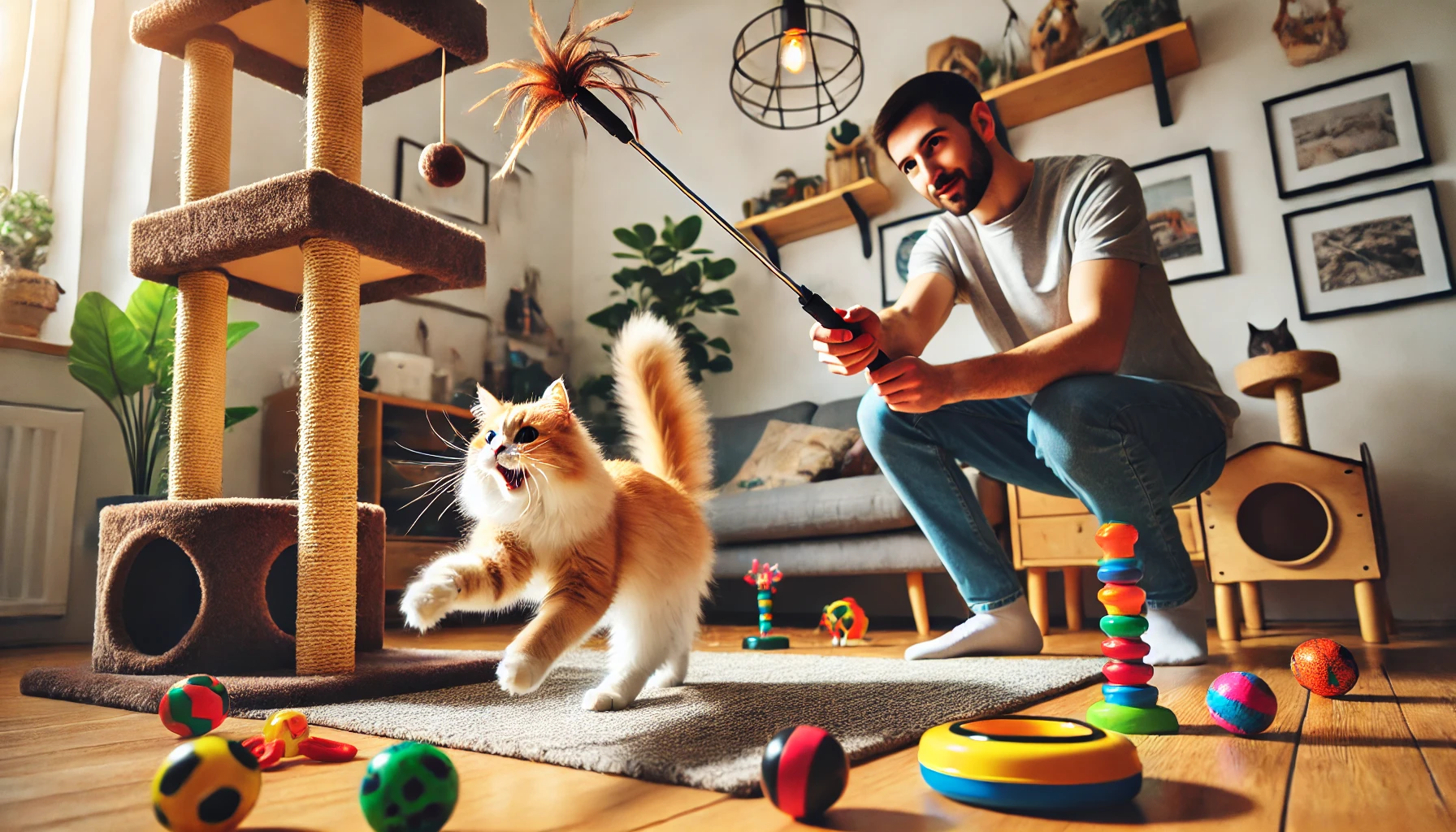
Encouraging Play and Physical Activity
One of the most effective ways to keep your cat active is by encouraging play.
Cats, by instinct, love to chase and pounce.
This behavior can be channeled into interactive play that provides both physical and mental stimulation.
Use predatory-like toys such as feather wands or laser pointers to create hunting-like actions.
- Interactive Toys: Toys such as feather wands, laser pointers, or moving toys are excellent for encouraging your cat to play. These activities encourage your cat to move, jump, and run.
- Play Time: Try to play with your cat at least twice a day for 15-20 minutes per session to keep them active.
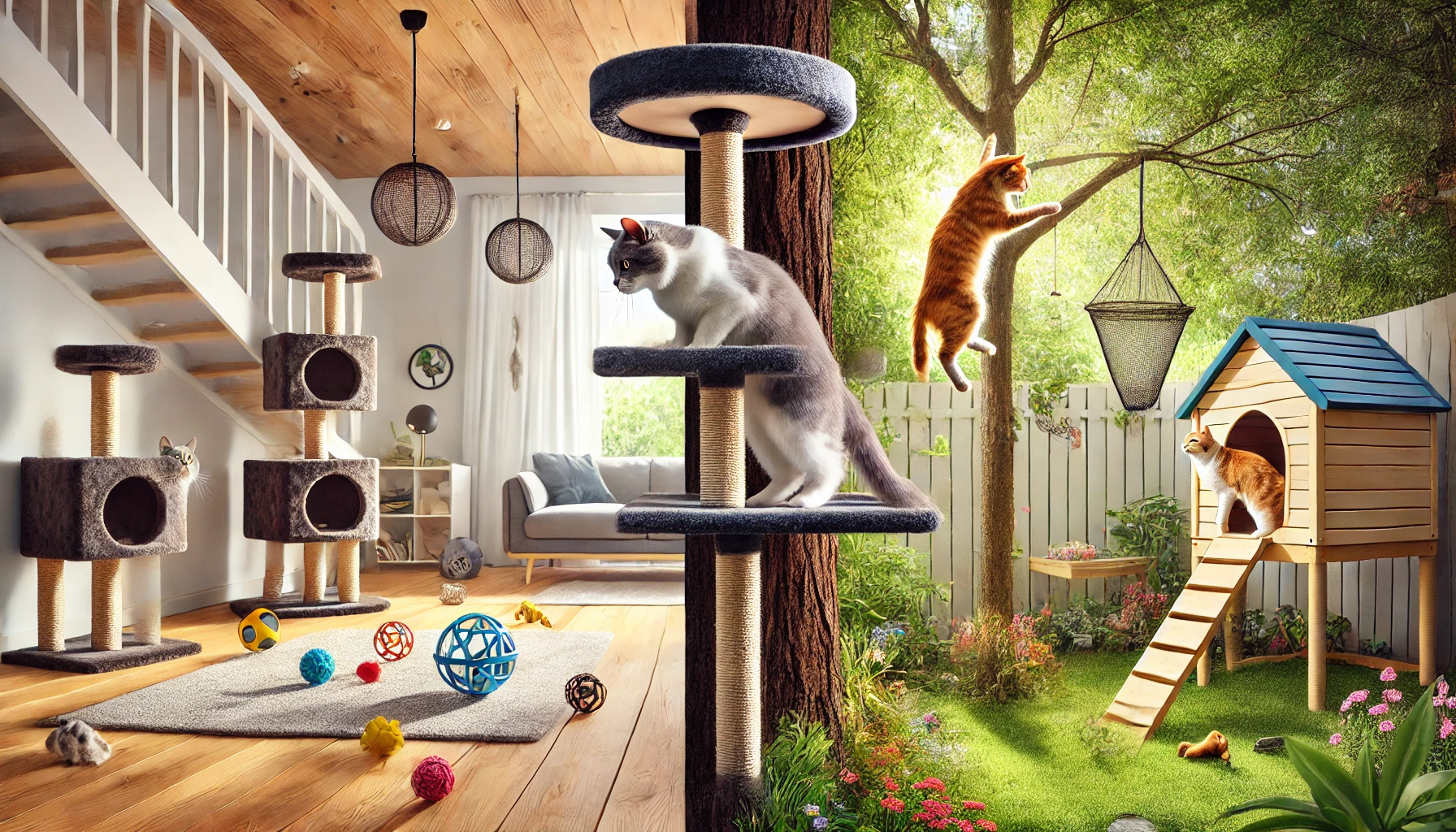
Indoor vs. Outdoor Cats: Managing Activity Levels
The activity levels between indoor and outdoor cats can differ greatly.
Outdoor cats naturally get more exercise through exploring, hunting, and climbing.
Indoor cats often lead more sedentary lives, contributing to feline obesity.
To prevent this, you need to create an active environment for indoor cats.
- Climbing Structures: Provide indoor cats with climbing structures such as cat trees or shelves to encourage jumping and climbing.
- Safe Outdoor Time: If possible, allow your cat supervised time outdoors using a harness or an enclosed outdoor space for safe exploration and exercise.
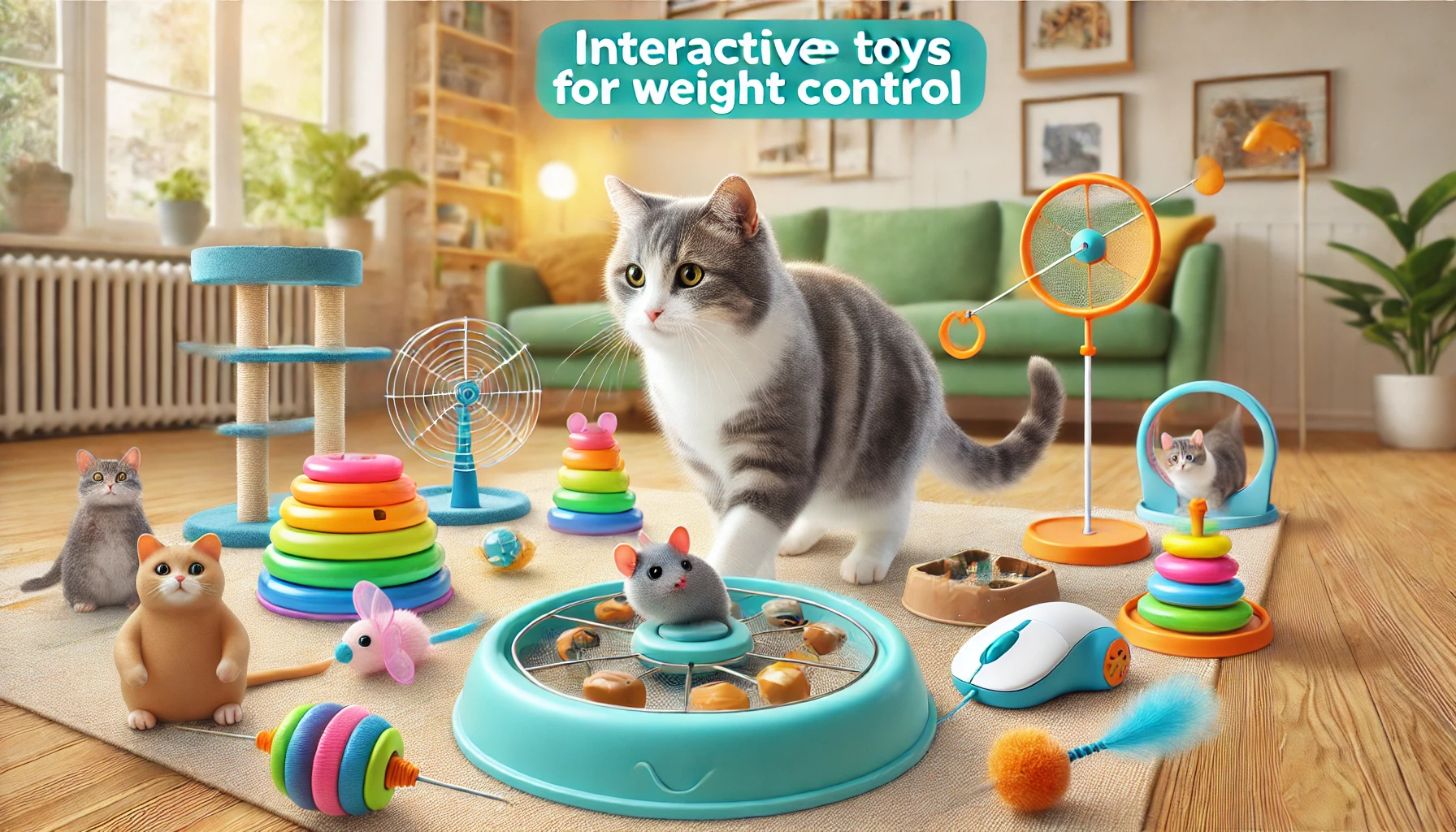
Interactive Toys for Weight Control
Interactive toys are an entertaining way to maintain your cat’s physical activity and help control their weight.
Toys that encourage natural hunting behavior are particularly effective at keeping your cat moving.
These toys not only provide physical exercise but also engage your cat’s mind, helping prevent boredom and the associated behaviors like overeating.
- Feather Wands and Fishing Rod Toys: These imitate prey and encourage your cat to jump, pounce, and chase—excellent for burning calories.
- Laser Pointers: Cats love chasing laser pointers, making them perfect for a quick, fun, and active play session. Just remember to end the session with a real toy or treat they can “catch.”
- Automatic Toys: Motorized or self-moving toys can be left on during the day to keep your cat entertained and active even when you’re not around.
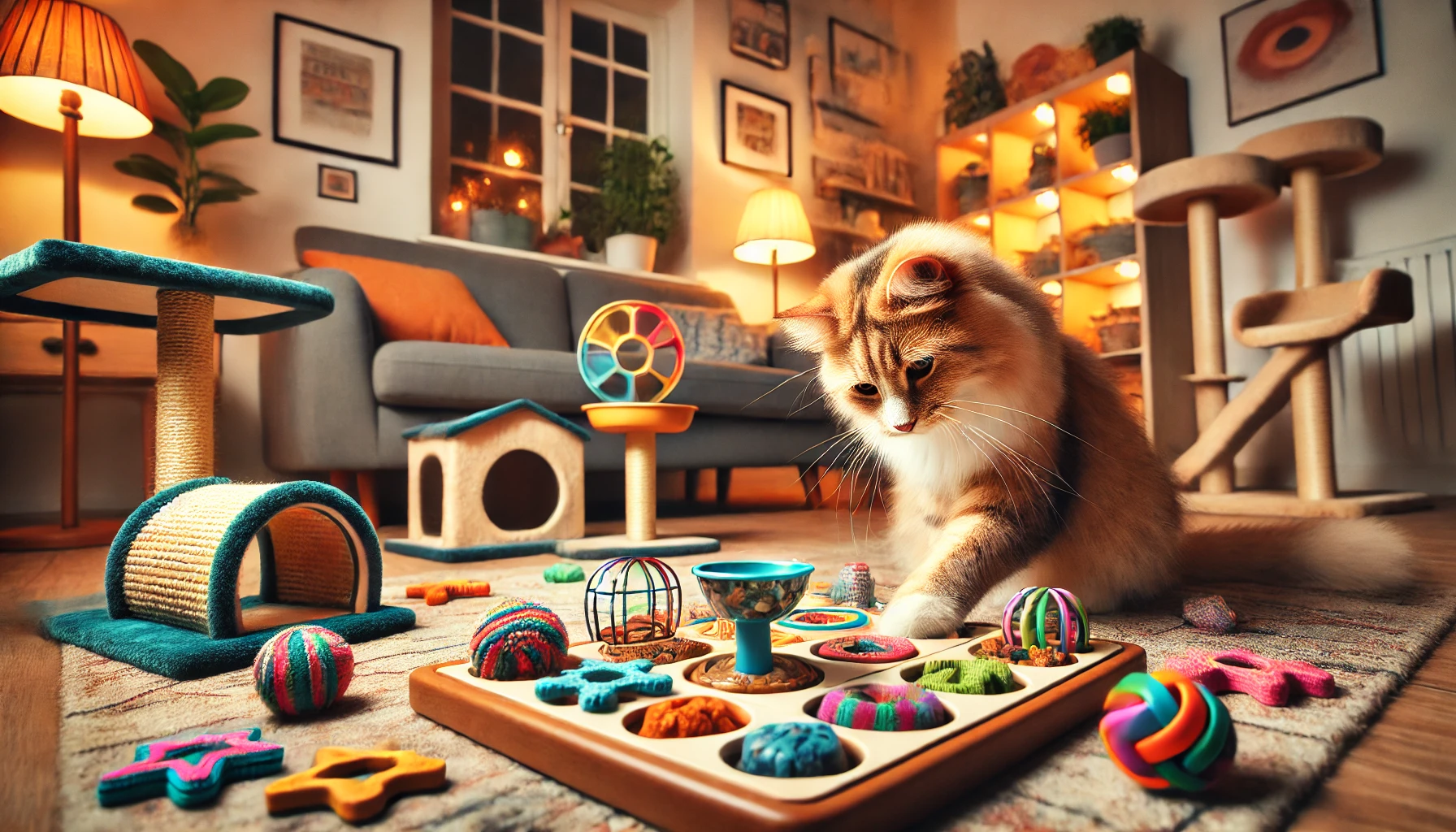
The Importance of Mental Stimulation for Active Cats
Mental stimulation is as important as physical activity in preventing obesity in cats.
Cats are highly intelligent creatures, and boredom can lead to overeating or laziness.
Challenging your cat with toys and puzzles can help keep them mentally sharp and active.
- Food Puzzles: Food puzzles not only slow down eating but also make your cat think and work for their food, providing both mental and physical benefits.
- Interactive Games: Problem-solving games, such as hiding treats under cups or figuring out how to get a treat out of a maze, can keep your cat entertained and mentally stimulated.
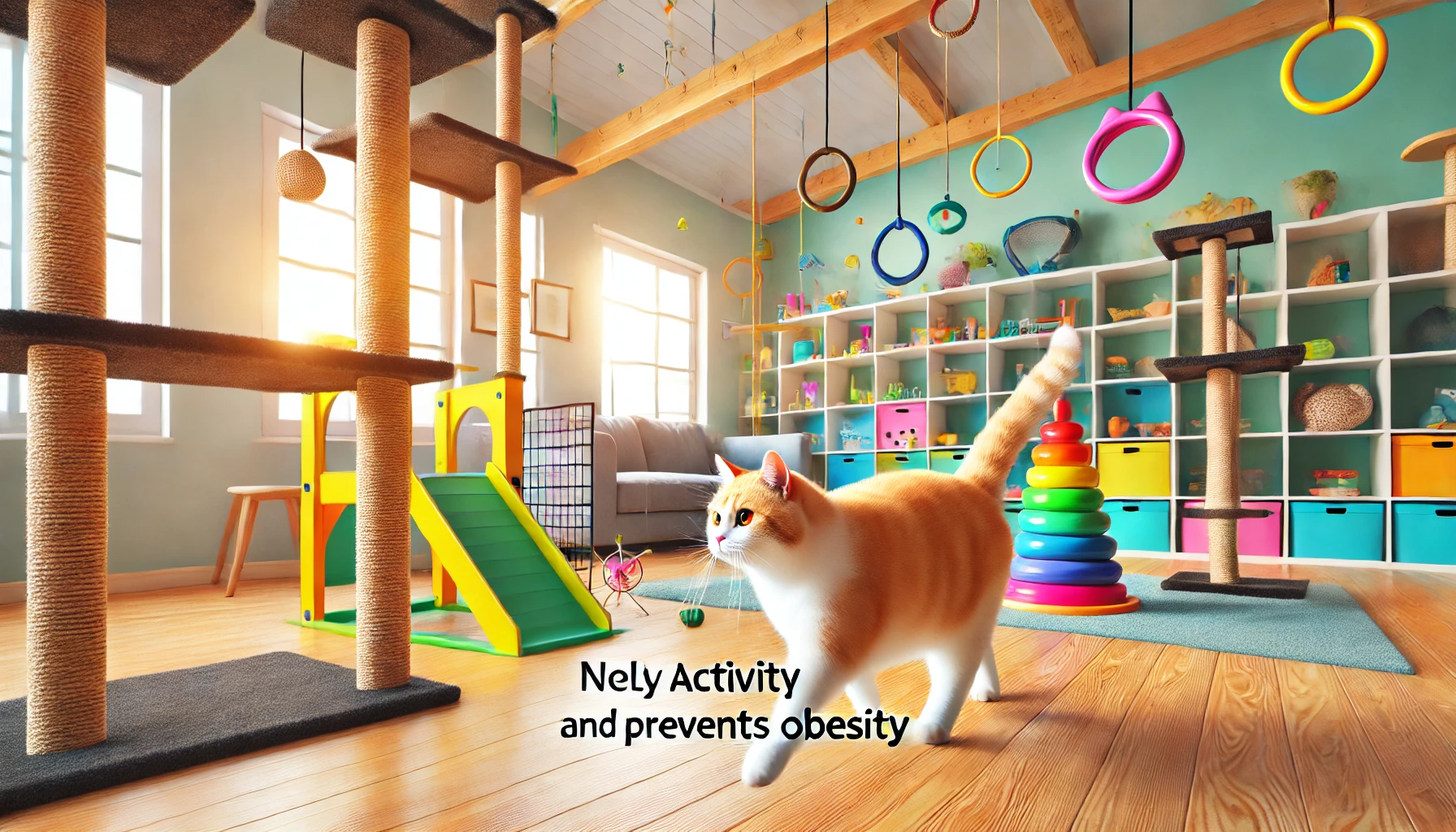
How to Create an Environment to Prevent Obesity
Creating an environment that encourages physical activity is crucial for preventing feline obesity.
Cats are naturally curious and love to explore, so providing them with a stimulating and interactive space helps keep them active.
- Vertical Space: Offer vertical spaces like cat trees, shelves, and climbing towers to encourage climbing, which increases physical activity.
- Varied Toys: Rotate toys regularly to keep your cat engaged and interested. The variety helps prevent boredom and encourages regular activity.
- Access to Windows: Cats love observing the outside world, and access to windows provides mental stimulation and encourages movement as they watch their surroundings.
By engaging your cat in adequate physical and mental stimulation, you can effectively prevent feline obesity and keep them healthy and active.
Exercise is vital for cats to maintain a healthy weight. Encourage physical activities and play to prevent feline obesity.
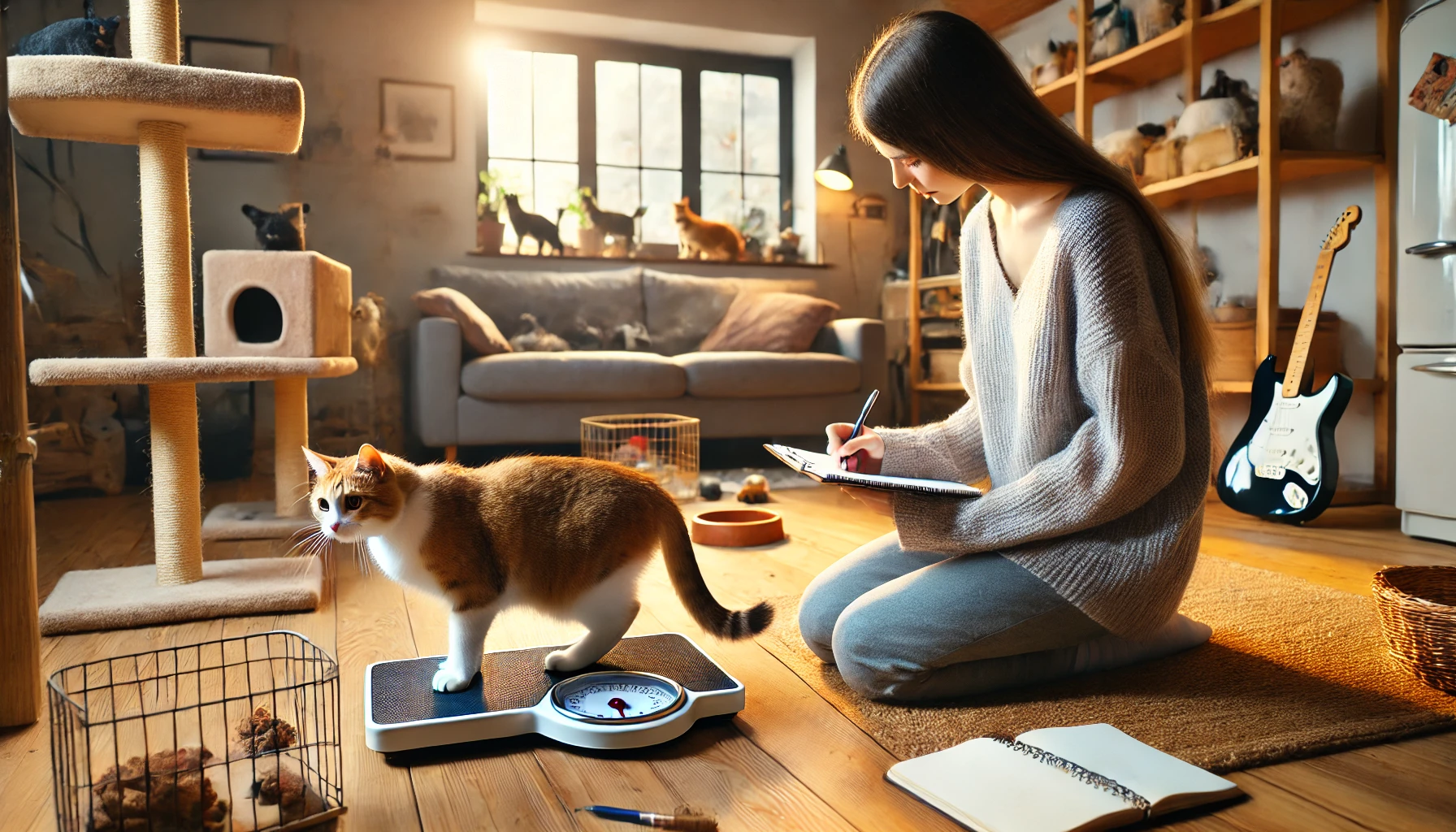
Monitoring and Adjustments to Your Cat’s Health Plan
Keeping a close watch on your cat’s weight and health is vital in preventing obesity in cats.
Regularly monitoring their weight and making necessary adjustments to their diet and activity levels will help ensure that your cat stays fit.
A proactive approach to their health plan allows for early detection of weight gain, enabling necessary changes before long-term issues arise.
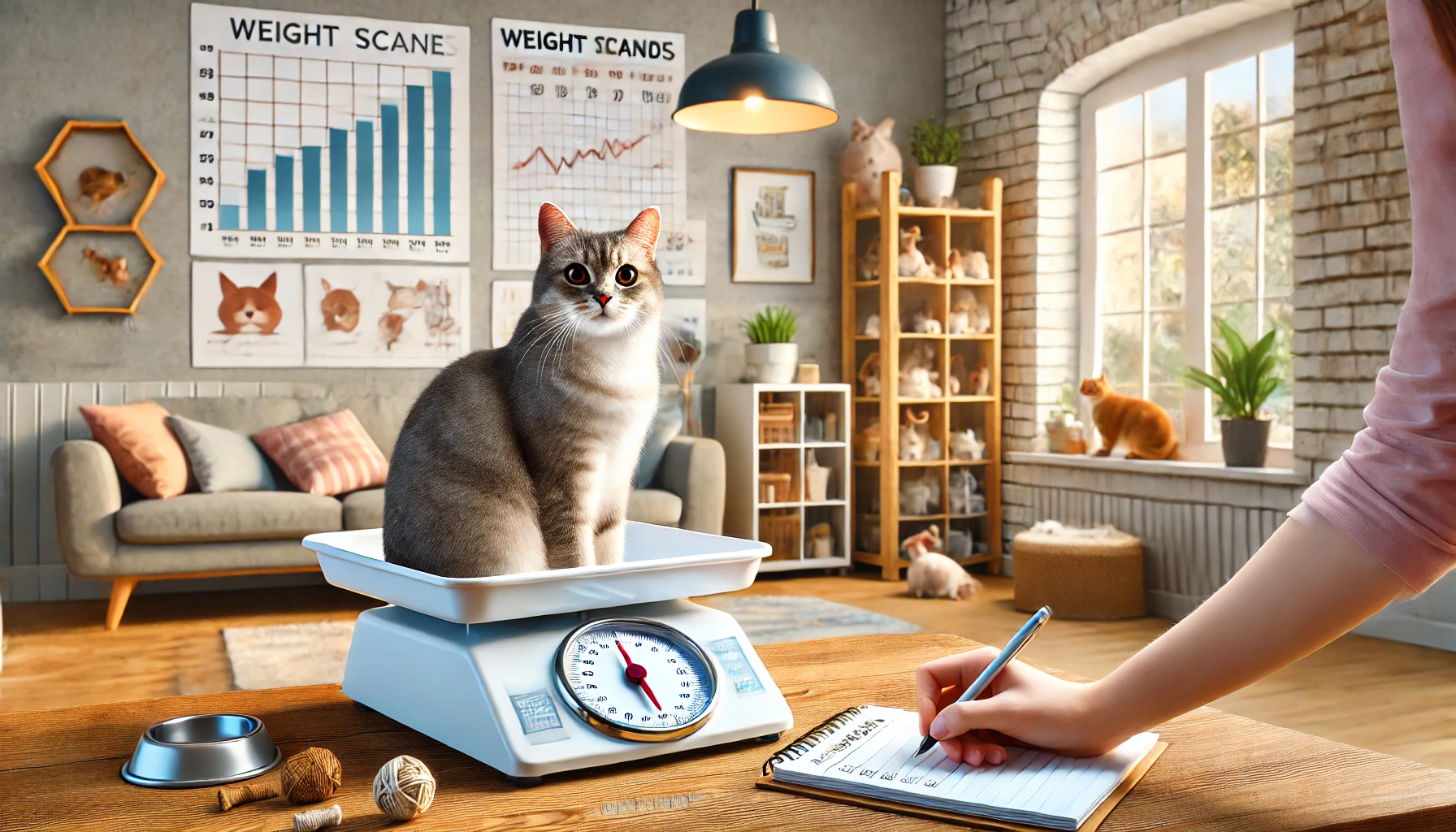
Monitoring Changes in Your Cat’s Weight
One of the best ways to prevent cat obesity is through regular weight checks.
You can do this at home using a pet scale or during vet visits for weigh-ins.
Monitoring every other week can catch changes early so you can adjust your cat’s diet or exercise routine accordingly.
Even a small amount of weight gain can significantly impact your cat’s health.
- Home Weigh-Ins: Your cat’s weight can be measured using a pet scale or a regular bathroom scale. First, weigh yourself, then weigh yourself while holding your cat, and subtract the difference to get your cat’s weight.
- Vet Checkups: Regular vet visits are important to monitor your cat’s weight and rule out any health issues contributing to weight gain.
- Weight Loss Goals: If your cat is overweight, work with your vet to set realistic weight loss goals and a timeline for achieving them.
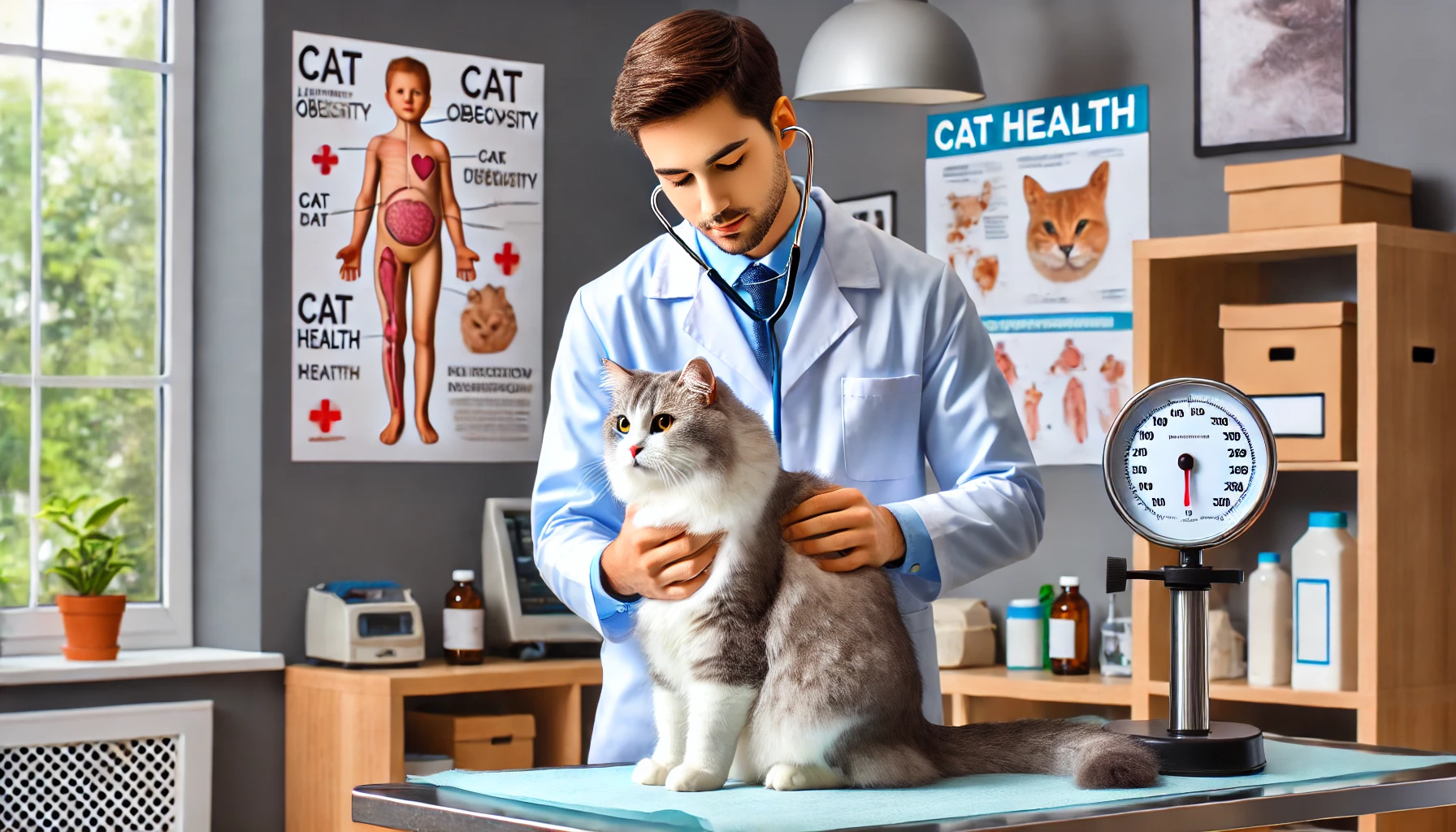
When to Consult a Veterinarian About Cat Obesity
If your cat continues to gain weight despite efforts to regulate diet and exercise, it may be time to consult a veterinarian.
Medical conditions such as hypothyroidism, diabetes, or other issues can predispose cats to weight gain.
Veterinary intervention may be needed to manage your cat’s weight effectively.
- Medical Conditions: Health issues like hypothyroidism, diabetes, or arthritis can contribute to cat obesity. A vet exam will help identify these conditions and provide appropriate management.
- Dietary Changes: Your veterinarian may recommend switching to a prescription diet specifically formulated for weight management.
- Workout Programs: A vet can assist in developing a safe and effective exercise plan for your cat, especially if they are significantly overweight or have health complications.
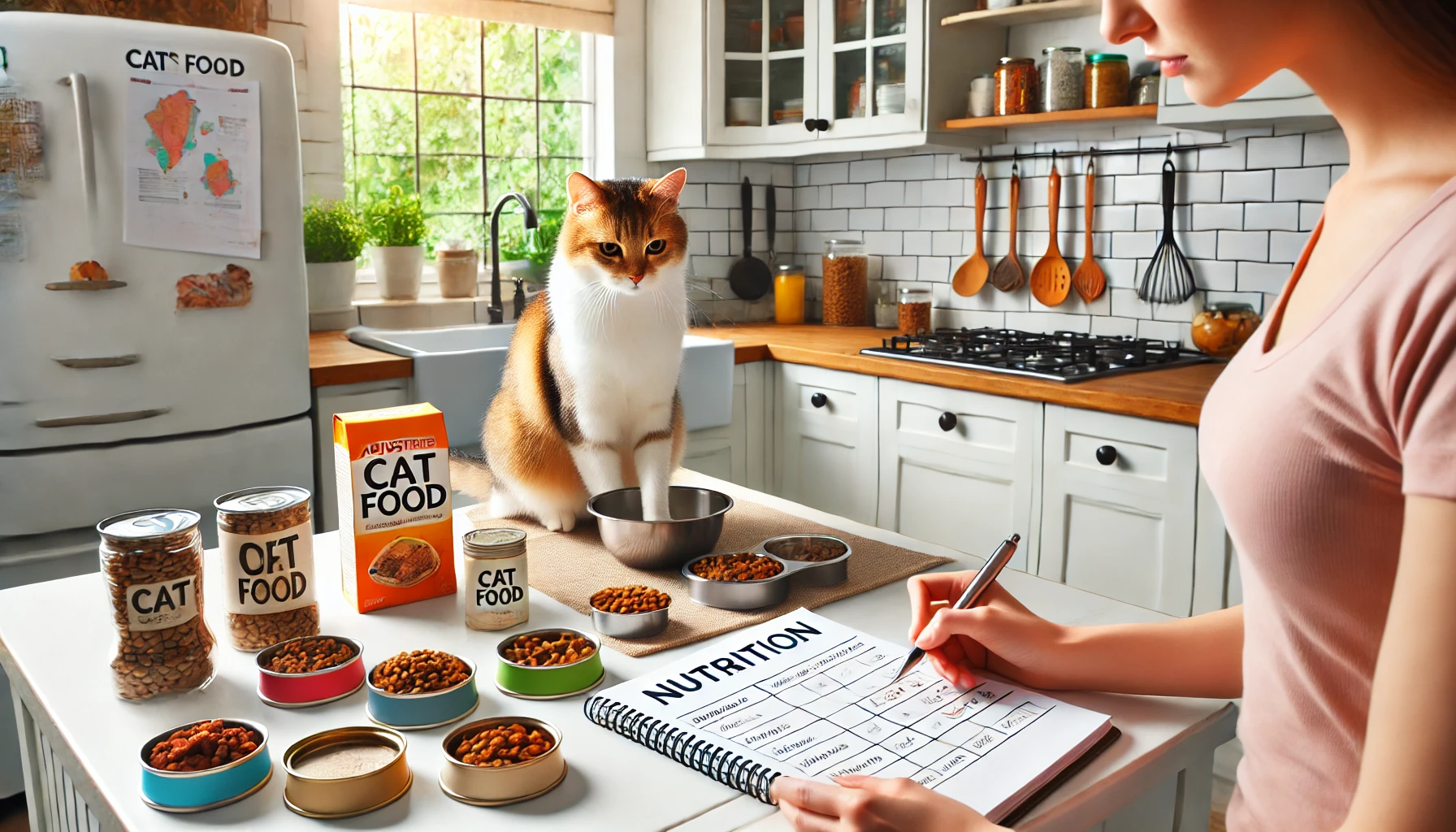
Adjusting Your Cat’s Diet Over Time
As cats age, their dietary needs change.
Senior cats may have slower metabolisms and require fewer calories than younger cats.
Adjusting your cat’s diet to reflect these changes is crucial for preventing cat obesity.
If your cat’s activity level increases or they lose weight, you may also need to adjust their caloric intake to maintain a healthy weight.
- Portion Control: Regularly monitor and adjust portion sizes based on your cat’s current weight and activity level. If your cat is gaining weight, reduce portions or switch to a lower-calorie food.
- Diet Transitions: Transition your cat to senior cat food or a prescription diet if recommended by your vet, especially for changes in metabolism or health needs.
- Increased Exercise: If your cat becomes more active, increase their caloric intake to support their higher energy needs.
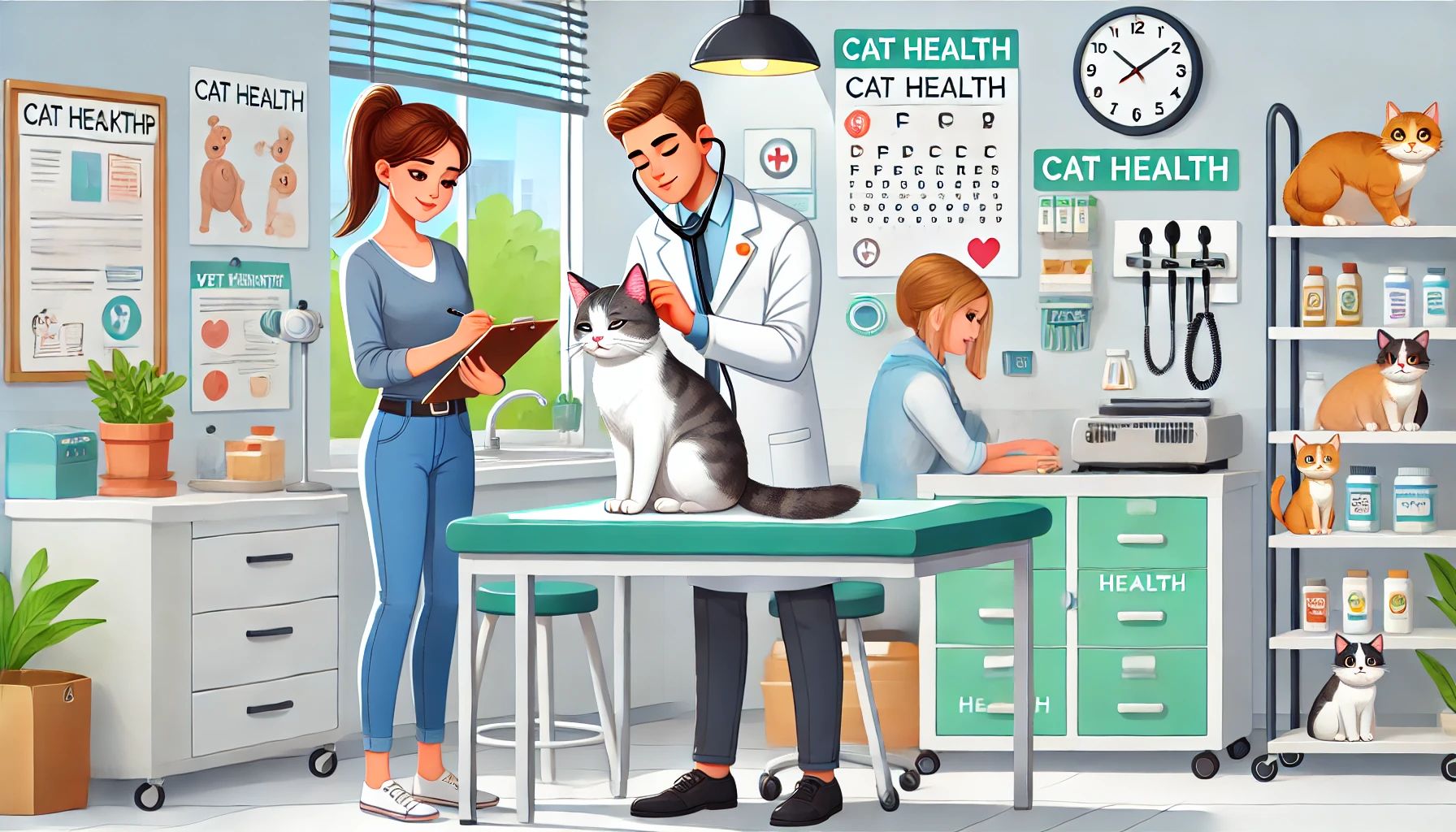
Understanding the Importance of Regular Vet Checkups
Regular vet checkups are crucial for monitoring your cat’s overall health, including cat obesity.
A vet can provide insights into weight management, diet adjustments, and exercise routines.
For most cats, annual or semi-annual vet visits are sufficient, but more frequent visits may be necessary if your cat has weight issues or other health concerns.
- Health Screenings: Routine checkups allow your vet to screen for diseases or conditions that can contribute to weight gain, such as diabetes or thyroid problems.
- Weight Management: A veterinarian can offer professional advice on managing your cat’s weight through dietary adjustments and increased activity levels in a safe and controlled manner.
- Preventive Care: Regular vet visits ensure that potential health problems are caught early, preventing more serious issues down the line.
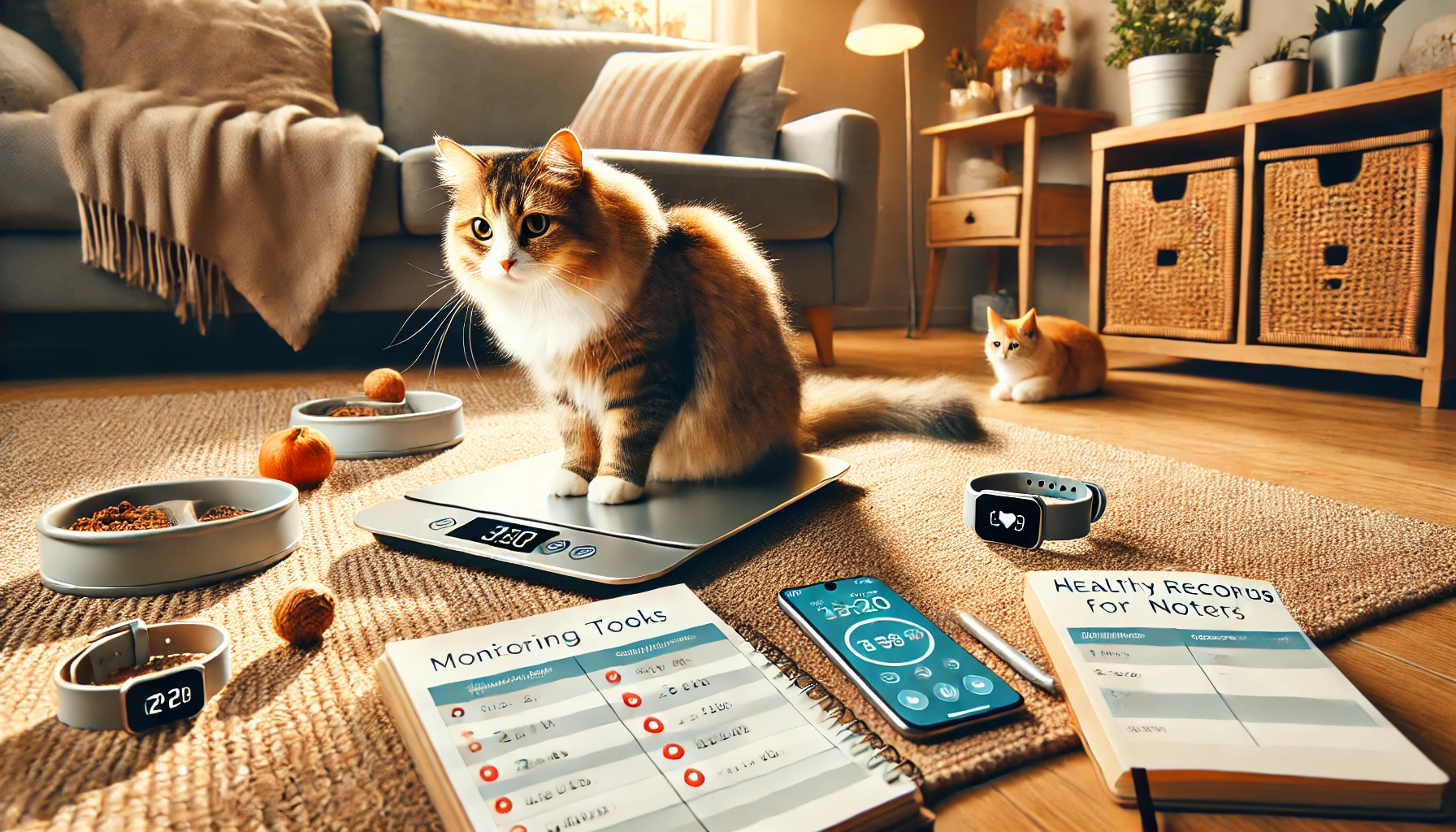
Monitoring Tools: Managing Your Cat’s Health at Home
Several tools are available to help monitor your cat’s health at home.
Smart scales, activity trackers, and calorie tracking apps can provide valuable data on your cat’s activity levels, weight, and overall health.
These tools make it easier to maintain a healthy weight and prevent cat obesity.
- Smart Scales: These scales track your cat’s weight over time, helping you identify trends and make adjustments as needed.
- Activity Trackers: Pet activity trackers monitor how much exercise your cat gets each day, allowing you to adjust their playtime or exercise routines accordingly.
- Calorie Tracking Apps: These apps allow you to track your cat’s daily food intake and caloric consumption, ensuring they stay within their target range for maintaining a healthy weight.
By being proactive and conducting regular health checkups, you can prevent cat obesity and help your feline friend live a long, healthy life.
Regular monitoring of your cat’s weight and making necessary dietary and exercise adjustments are crucial steps in preventing obesity.
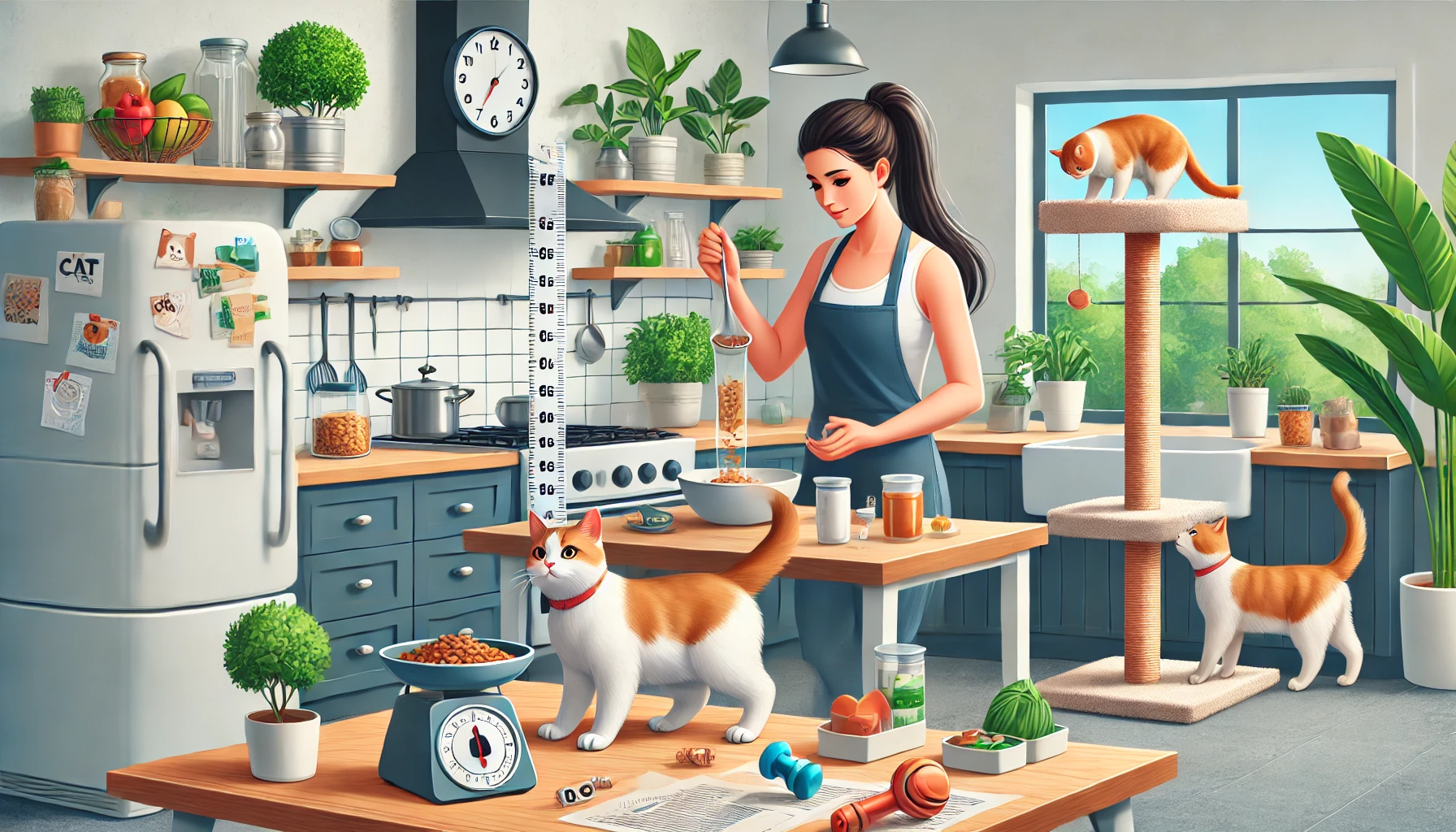
Comprehensive Measures to Prevent Cat Obesity
Prevention of obesity in cats is multilayered and entails attention to diet, exercise, health monitoring, and more.
By taking proactive measures, you can ensure that your cat stays within a healthy weight range, leading to a long and active life.
This article has outlined key strategies, from food selection to establishing effective feeding routines and participating in regular physical activities, that will help achieve this goal.
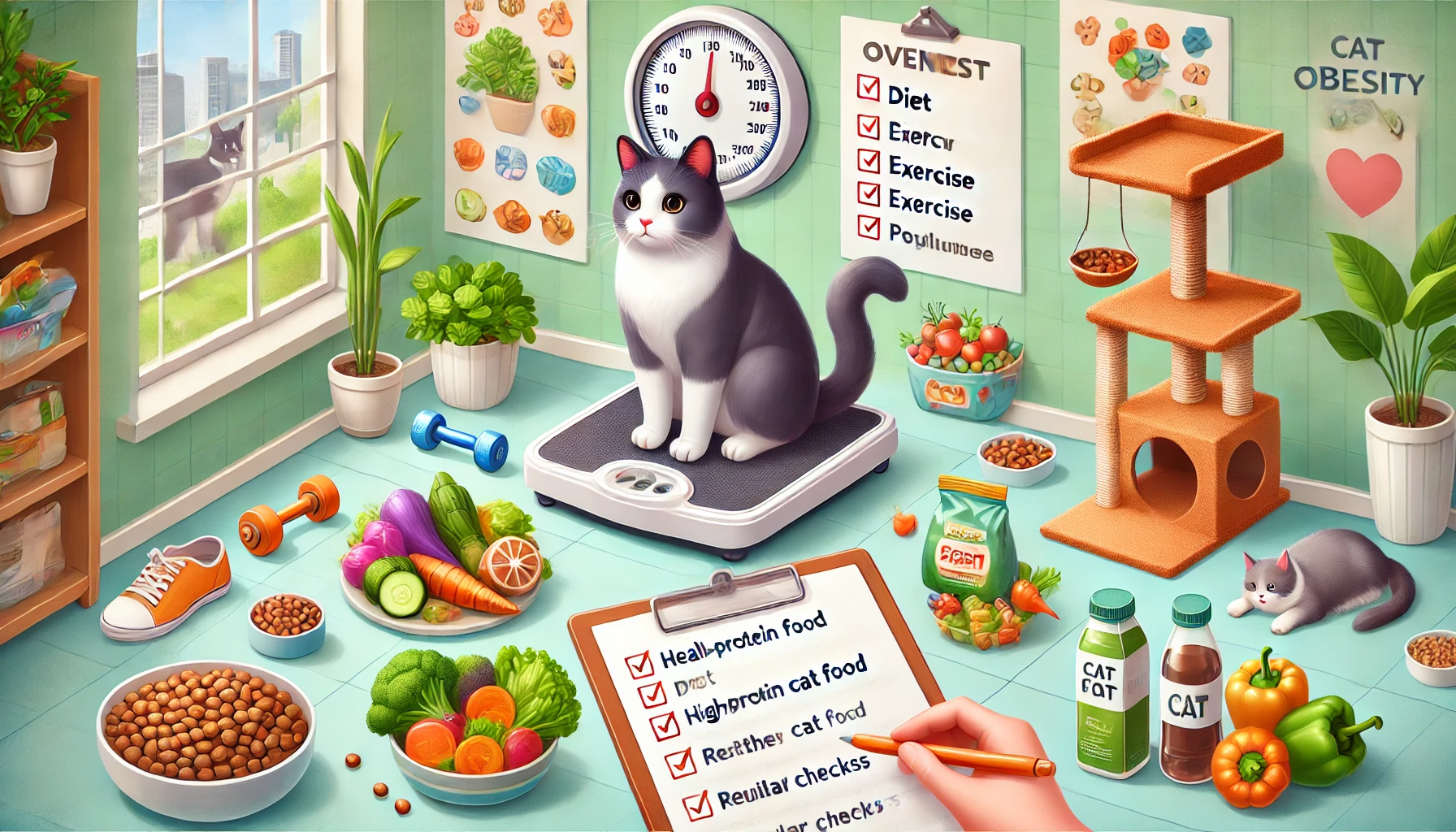
Overview for Managing Cat Obesity
Preventing cat obesity requires detailed attention to the various factors influencing your cat’s life.
Here is a summary of the key points to remember:
- Balanced Diet: Your cat’s food should include high amounts of animal-based proteins and minimal carbohydrates. Choose premium cat food with clear, nutritious ingredients.
- Portion Control: Avoid overfeeding by measuring portions accurately and maintaining a consistent feeding schedule.
- Regular Exercise: Stimulate your cat with daily play sessions using interactive toys for physical exercise and mental stimulation.
- Weight Monitoring: Regularly monitor your cat’s weight at home or during vet visits to catch early signs of weight gain.
- Consult Your Veterinarian: If your cat continues to gain weight despite dieting and exercise, consult a veterinarian to check for underlying health issues.
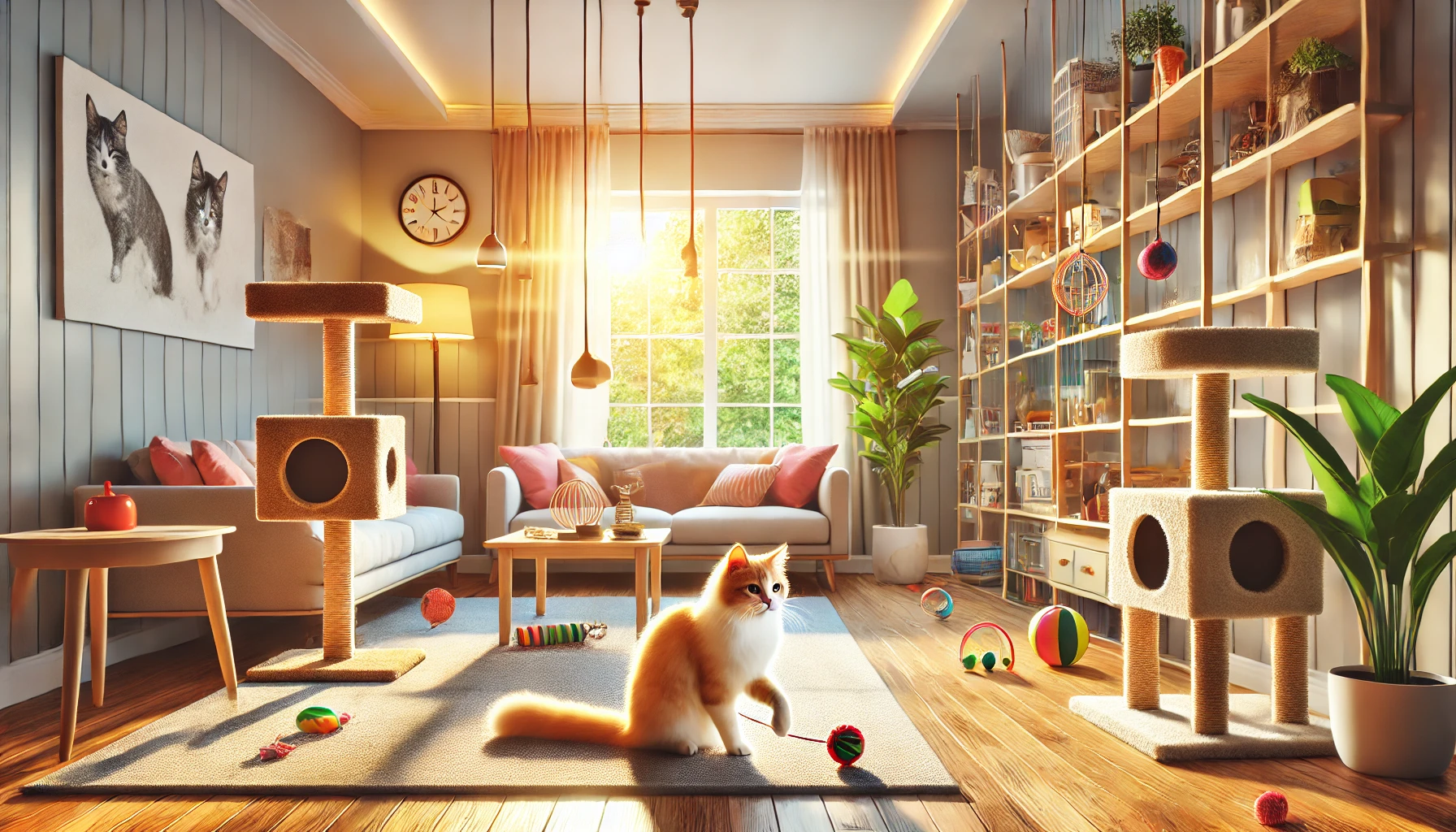
Creating a Healthy Environment for Your Cat
In addition to nutrition and exercise, creating an environment that encourages an active lifestyle and mental stimulation is crucial for preventing cat obesity.
Cats are naturally curious, and engaging them in enriching activities helps prevent a sedentary lifestyle.
Here are some ideas to consider:
- Offer Vertical Spaces: Provide your cat with access to vertical spaces like cat trees or shelves, encouraging them to climb and stay active.
- Use Puzzle Feeders: Use puzzle feeders to slow down meal times, offering mental stimulation and simulating hunting behaviors.
- Rotate Toys: Regularly change your cat’s toys to keep them engaged and avoid boredom, encouraging frequent movement.
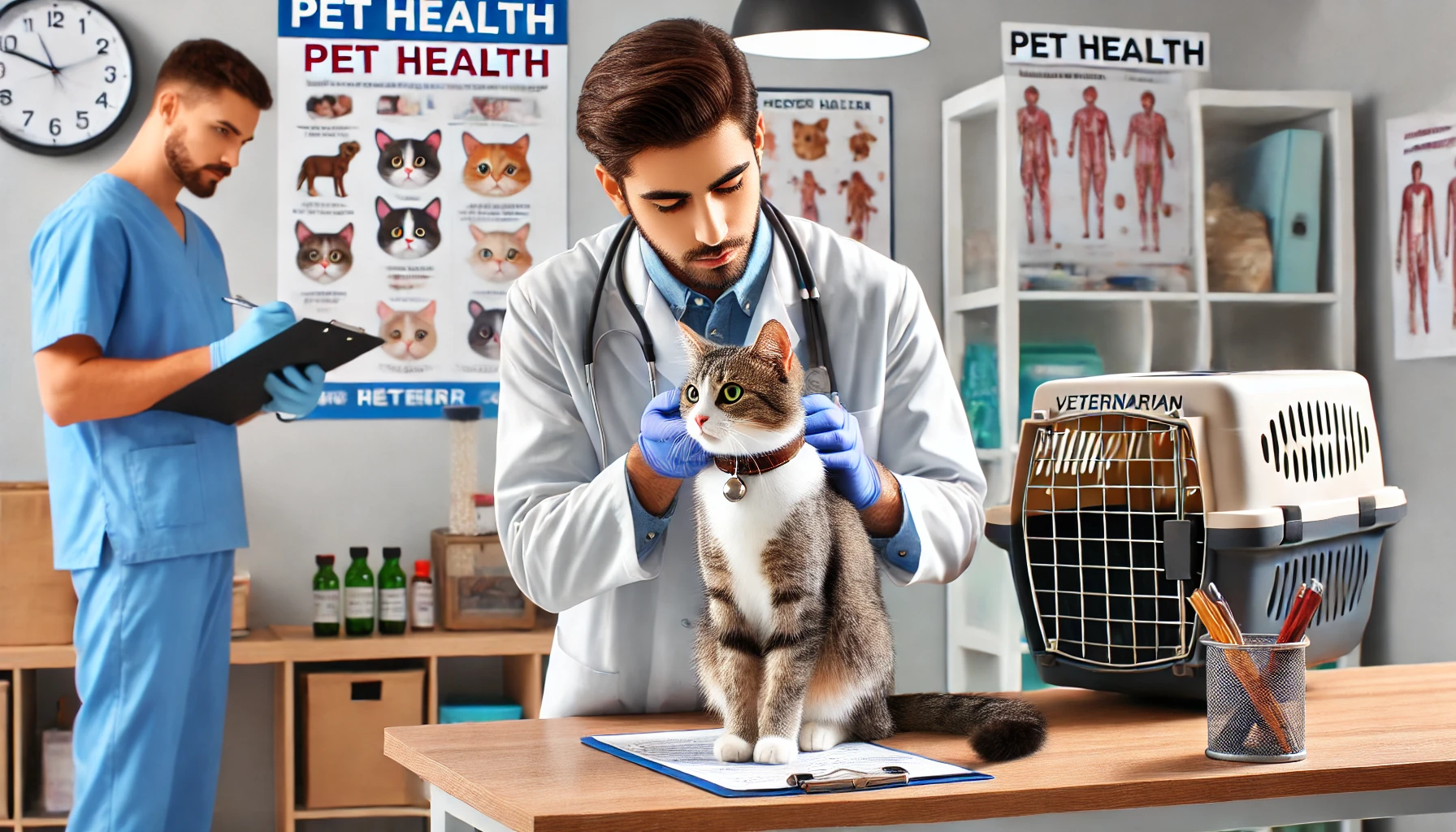
Ongoing Health Monitoring and Vet Visits
Maintaining your cat’s health includes regular vet visits and using modern tools to track activity and weight.
Staying on top of your cat’s health and adjusting their care routine as needed reduces the risks associated with cat obesity and its negative health effects.
- Smart Tools: Use smart scales and activity trackers to monitor your cat’s daily activity and weight over time.
- Veterinary Visits: Establish a regular schedule for veterinary visits to screen for and diagnose conditions like thyroid problems or diabetes, which are linked to weight gain.
- Adjust Diet and Exercise Programs: Modify your cat’s feeding and exercise programs as they age or when their energy needs change.
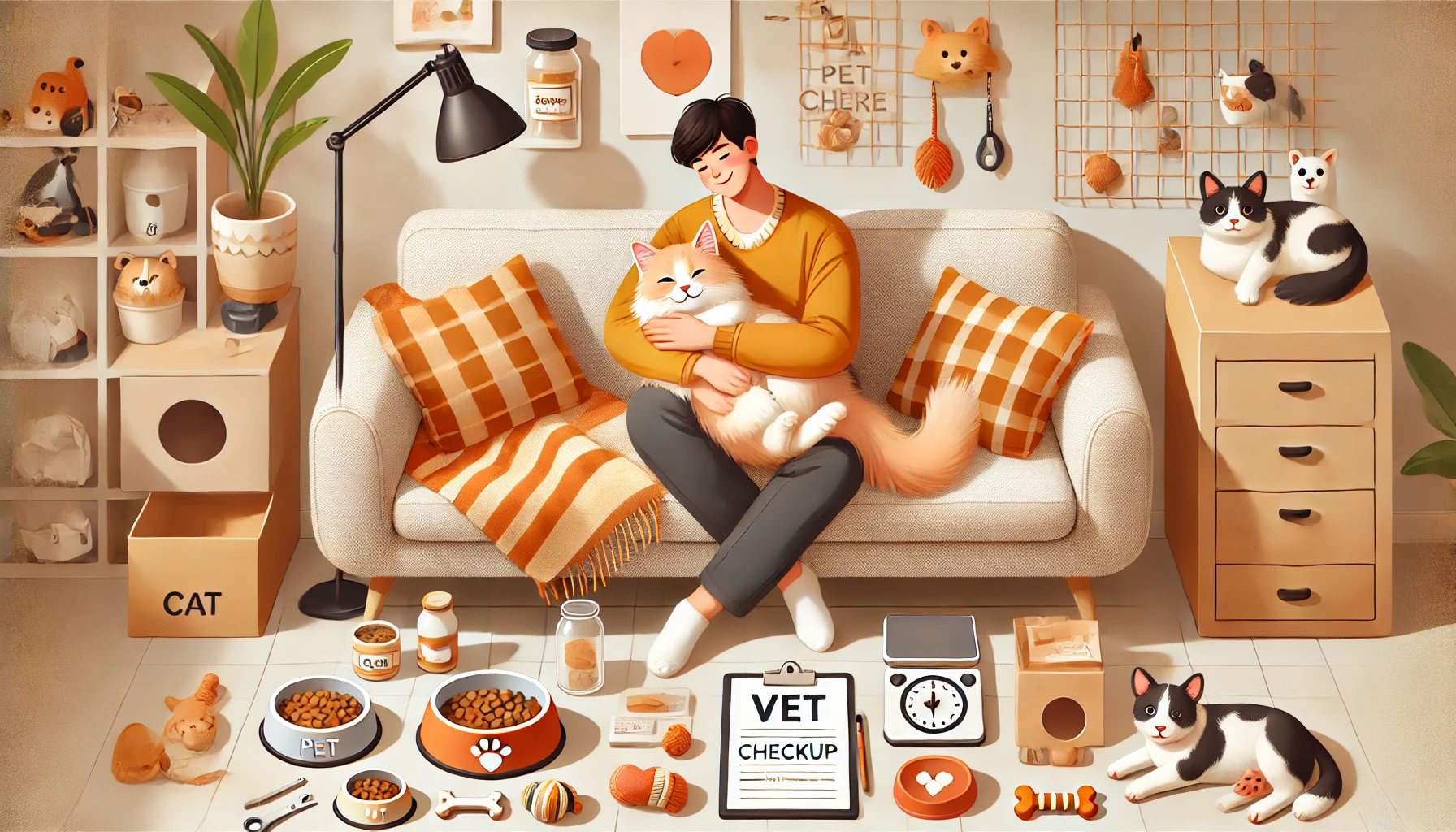
Conclusion: Lifelong Responsibility for Your Cat’s Health
Preventing cat obesity requires lifelong attention, dedication, and care.
Feeding a proper diet, encouraging regular exercise, creating a stimulating environment, and monitoring your cat’s health are all essential to ensuring your cat leads a long, healthy life.
Every small action you take contributes to improving their overall health, preventing obesity, and promoting vitality for many years.
Prevention of cat obesity requires a multifaceted approach that includes proper diet, regular exercise, and consistent health monitoring.
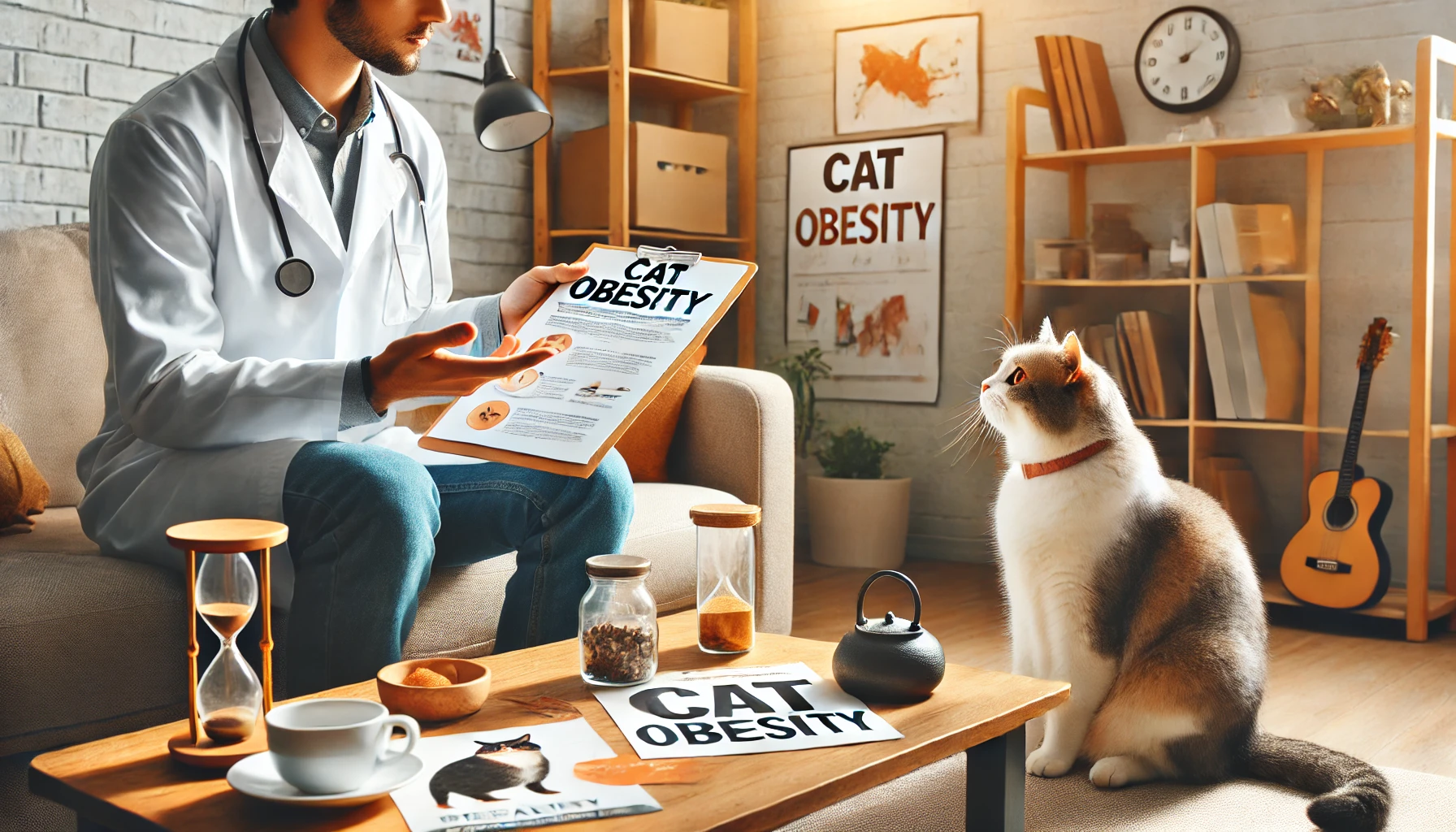
FAQ on Cat Obesity
Following are some of the most frequently asked questions about cat obesity and how to maintain a healthy weight for your feline companion.
What are the basic causes of obesity in cats?
The major causes of cat obesity are overfeeding, lack of physical activity, poor food selection, and sometimes associated health issues such as hypothyroidism or diabetes.
How can I determine if my cat is overweight?
If you cannot feel the ribs without excessive fat or see a clear waistline behind the ribs when viewed from above, your cat may be overweight.
Consult your veterinarian for a body condition evaluation.
How often should I feed my cat to prevent obesity?
Feeding your cat 2 to 3 times a day with portion control based on age, activity level, and health can help prevent cat obesity.
Avoid free-feeding.
Is it easier for indoor cats to become overweight than outdoor cats?
Yes, indoor cats are more prone to obesity due to lower activity levels compared to outdoor cats.
It’s important to engage them in regular play and mental stimulation.
What kind of food should I feed my cat to avoid obesity?
To avoid cat obesity, provide a high-protein, low-carbohydrate diet with high-quality ingredients.
Avoid foods with fillers such as corn and soy.
How can I help my overweight cat lose weight?
To help your cat lose weight, reduce portion sizes, switch to lower-calorie food, and ensure daily exercise.
Consult your veterinarian for a personalized weight-loss plan.
What health risks does cat obesity create?
Cat obesity can lead to diabetes, arthritis, heart disease, liver problems, and a shortened lifespan.
Maintaining a healthy weight is essential for your cat’s long-term health.
What role does exercise play in preventing obesity in cats?
Exercise is crucial in preventing cat obesity by burning extra calories, maintaining muscle mass, and stimulating the mind, reducing the risk of overeating due to boredom.
When should I take my cat to the vet regarding weight issues?
If your cat is gaining weight despite dietary changes and increased exercise, or if they have trouble moving or grooming, consult your vet for a health assessment.


